7. Index Access Certificate (AC) An access certificate to any machine in the Eternity Service. It includes an address or a generalized address (so called onion), Public Key of the server, expire time of the ceritficate and other voluntary items. ACID In the Service unambiguous identifier of Access Certificate. Acs (Access Certificate Server) A server, which publishes Access Certificates of other servers in the Service. Bank A program managing payments and payment's transactions in a financial institution geared to the Eternity Service. Onion Generalized address of a machine in it's Access Certificate. Onion includes ciphered path to the given server. Cipherer An object encapsulating RSA cryptographical algorithms. Denial Of Service Attack An attack, which obstructs access to a service. DES A symetric cryptographical algorithm (Data Encryption Standard). Eso (Eternity Server) A server offering main services in the Eternity Service - storing and searching a file. Eternity Service (ES) A service offering a safe way in storing and searching a file and preventing the file against modification or delete. GMessage (Generic Message) An auxiliary class offering an easy way to work with messages. Client A program for user, which wants to store or search a data in the Service. MAC (Message Authentification Code) A checksum over data, used for prooving ownership of the file. Majordomo A main thread of a server managing incomming messages. Middle Attack Going through the Service a data are in "the middle" of a path encrypted only with Public Key of the recipient. That is why it is easy to distinguish information about message ID, number of block in the message etc. Mix Something like a remailer. A server used for "reposting" of messages, generating padding and an onion. O-Authentification (OAuth) A secret key, known only to a bank and a client. It is used for computing MAC. Onion-routing A message, which goes through machines in a network, is gradually uncovered slice after slice. Every slice hides information about IP address of a next machine only. This computer has the key to discover next recipient etc. This way each computer knows its predecessor and successor only, but does not know real depositor or recipient. Padding Filling incomming messages, which were manipulated, to its original size (before sending them). PKCS RSADSI set of cryptographical standards. Payment Plan A plan of payments, which is sent by an Eso through a Client to a Bank. Receiver An object operating an input socket. RSA Asymetric encryption algorithm. RSADSI RSA Data Security Inc. RSAEuro A cryptographical library, compatibile with RSARef-toolkit. RSARef RSADSI cryptographical library, based on PKCS standards. S-Authentification (SAuth) A secret key, known only to a bank and a Eso. It is used for identification of the Eso. Sealed S-Authentification (SealedSAuth, SealSA) An S-Authentification encrypted with Bank's Public Key. Sender An object operating an output socket. Six A general service over a Mix. TCB (Trusted Computing Base) A cryptographical device, which has its Secret Key stored in hardware, and which can realize simple cryptographical algorithms. It can decrypt data with its Private Key and encrypt them with another key. It is garanted that nobody can see not encrypted plain data outside the TCB. TCBWrapper A class encapsulating general behavior of TCB. Traffic analysis Watching network traffic for analysis of posted messages. -------------------------------------------------------------------------------- 8.3 Architecture All servers in the Eternity Service have to communicate together in the environment of Internet. An user needs to store his file on a server, which stores data and makes possible its downloading, bank needs to agree with this server about payments etc. From a bird perspective whole Service could look like this:

 The servers on the picture would provide whole functionality of the Service.
But the problem is, that we have bigger demands on the Service security. If
there would be an easy way to find out where are the servers managing stored
files, no difficulty should appear when discarding or damaging these servers.
This could leed to the collaps of the whole System (see chapter 11.). To
prevent from such a situation or reduce chances of incidental attacks on the
Eternity Service all communication goes through special servers (Mixes), which
make very difficult to trace the communication and mask real executive of the
Service. From the view of the formerly mentioned servers Mixes on the path are
transparent.
Each executive server tightly cooperates with one Mix. Typically these are two
processes runing on one machine or on two machines connected by a controlled
(secure) network. For the server this Mix is a gate to the Eternity Service.
On the other hand Mix does not distinguish whichone of the executive servers
it communicates with - it is easily service above Mix - so called Six. The
following picture shows used architecture.
The servers on the picture would provide whole functionality of the Service.
But the problem is, that we have bigger demands on the Service security. If
there would be an easy way to find out where are the servers managing stored
files, no difficulty should appear when discarding or damaging these servers.
This could leed to the collaps of the whole System (see chapter 11.). To
prevent from such a situation or reduce chances of incidental attacks on the
Eternity Service all communication goes through special servers (Mixes), which
make very difficult to trace the communication and mask real executive of the
Service. From the view of the formerly mentioned servers Mixes on the path are
transparent.
Each executive server tightly cooperates with one Mix. Typically these are two
processes runing on one machine or on two machines connected by a controlled
(secure) network. For the server this Mix is a gate to the Eternity Service.
On the other hand Mix does not distinguish whichone of the executive servers
it communicates with - it is easily service above Mix - so called Six. The
following picture shows used architecture.
 --------------------------------------------------------------------------------
11. System safety
--------------------------------------------------------------------------------
11.1. Onion routing
Most of the current systems for safe communication are focused on securing the
content of messages using symetric or asymetric keys. These systems take for
granted that communicating parties know the exact address of each other.
Besides that they also leave apart the question of traffic analysis. For our
system, that is trying to hide servers storing data as much as it is possible,
reavealing the identity of communicating parties could be fatal. It would be
easy to ask for a document and then destroy those servers that offered it.
That is why Eternity Service utilizes algorithm known as onion routing. This
algorithm is designed so that the communicating entities do not know each
other's identity. Using this algorithm the messages are sent through a number
of hops (Mixes) in such a way that every Mix on the way knows just the address
of its predecesstor an successtor and has no idea of what its position in the
chain is. The only exception is the last Mix that recognizes that he is last
and passes the message to its Six.
In the header of any message there is stored encrypted information about the
address of next hop. Mix decrypts this info after receiving the message from
network and finds out where to send the message next. The next Mix repeats
this procedure and forwards the message further. Because the private key of a
particular Mix is known only to this Mix, it is really hard for the attacker
to find out he address of the next hop and even harder to find out the final
destination of the message.
Forwarding message through many hops gives us quite a good protection against
traffic analysis. It is also important to choose the right Mixes to
communicate through. Their distribution should ensure that they are not under
control of one authority, that could get an idea of what is going on by
looking at the traffic routed between its Mixes.
--------------------------------------------------------------------------------
11. System safety
--------------------------------------------------------------------------------
11.1. Onion routing
Most of the current systems for safe communication are focused on securing the
content of messages using symetric or asymetric keys. These systems take for
granted that communicating parties know the exact address of each other.
Besides that they also leave apart the question of traffic analysis. For our
system, that is trying to hide servers storing data as much as it is possible,
reavealing the identity of communicating parties could be fatal. It would be
easy to ask for a document and then destroy those servers that offered it.
That is why Eternity Service utilizes algorithm known as onion routing. This
algorithm is designed so that the communicating entities do not know each
other's identity. Using this algorithm the messages are sent through a number
of hops (Mixes) in such a way that every Mix on the way knows just the address
of its predecesstor an successtor and has no idea of what its position in the
chain is. The only exception is the last Mix that recognizes that he is last
and passes the message to its Six.
In the header of any message there is stored encrypted information about the
address of next hop. Mix decrypts this info after receiving the message from
network and finds out where to send the message next. The next Mix repeats
this procedure and forwards the message further. Because the private key of a
particular Mix is known only to this Mix, it is really hard for the attacker
to find out he address of the next hop and even harder to find out the final
destination of the message.
Forwarding message through many hops gives us quite a good protection against
traffic analysis. It is also important to choose the right Mixes to
communicate through. Their distribution should ensure that they are not under
control of one authority, that could get an idea of what is going on by
looking at the traffic routed between its Mixes.

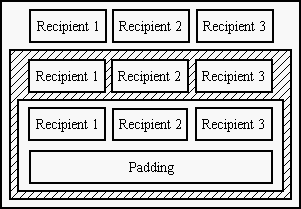 Another problem that comes with increasing the length of path through Mixes
can be disfunction of one or more Mixes on the way. This is more noticeable
under ocasions when the path of Mixes is specified in advance and shoul be
valid for a long time. To work around this problem we implemented a more
sofisticated variant of onion routing. In our implementation there is duplicit
information in each peel of message header that specifies multiple Mixes that
the message can be sent to. The message can be in case of failure of one Mix
routed through a different path. Choosing the next hop randomly from those
specified in header can help to distribute the load between several Mixes.
This has the effect of traffic analysis being even harder.
In our implementation we send the message to the first available Mix. Changing
this behaviour to the random one means easy modification of Sender object. It
would be nice to introduce a check that would prevent inserting a Mix
certificate into a peel twice. This should be implemented in MesageCreator
(Mix) in methods MakeMoreOnionLayers and similar. Onion routing is mostly
implemented in object Translator that tightly cooperates with MessageCreator.
--------------------------------------------------------------------------------
11.2. TCB
It has not to be technology or hardware what can be the weak place of the
system, human factor plays its role as well. Such a weak place could be e.g.
an administrator of an Eternity Server - server which maintains stored files.
What will do an administrator who is threatened to delete certain file from
his computer? With a knife on his throat he will delete it almost certainly.
Such a possibility would lower the trustworthy of the system in a large way.
But what will he do not given a chance to even find out what files are
stored on his server? Surely, it is possible to physically liquidate the
server, but there is no software capable of avoiding this, on the other hand
not even government would probably dare to keep someone away from doing his
business by demaging his property.
The situation, when even an administrator has no chance to find out what
data are stored on his server, can be reached by a simple cryptographical
device, which will store its private key purely in hardware and which will
be able to realize ciphering algorithms (including operation that will get
data ciphered with device's public key and return the same data encrypted
with some other key not letting the data to be seen decrypted from outside
the device). This device we call TCB - Trusted Computing Base.
Using the mentioned mechanism it is possible to reach the state when even
the administrator of a file storing server does not know what data it
maintains. Data will come encrypted with public key of HW device, which will
decrypt them using its secret key and encrypt them again with another key in
one step, thus decrypted data will not leave TCB. After finishing this the
data are ready to be stored on a disk. So our goal is reached. It is
possible to use the same mechanism on any data which need to stay hidden to
an administrator's eye.
TCB has to have a way to remember what key it used to store what data.
These realtions must be kept outside the TCB's hardware, because TCB has not
enough memory on its disposal. But to hide even this information we use the
key stored in TCB's hardware as a master key of a key hierarchy, which is
used to encrypt all information that cannot be seen by server administrator.
--------------------------------------------------------------------------------
11.3. Used cryptography
Security of the whole Service is ensured by using good cryptography
algorithms. We make use of ciphering in the Service for:
- Privacy of transmitted information because of the great importance of the
contens. This is needed for ensuring anonymous communication.
- Processing messages during Mix traversal. It is needed for data to look
different when it go out of Mix. This is defense against traffic analysis.
- Privacy of stored data (inside Eternity servers). This arrangement
defends against outside enemy (enemy wants to destroy the data) and also
defends an administrator, because he doesn't know what kind of data is
stored inside his Eternity server. Administrator can be defended only if
a special hardware is used (see TCB).
In our implementation we use combination of symetric and asymetric
cryptography. Asymetric ciphers are used mostly for privacy of transmitted
symetric keys, symetric ciphers are used for privacy of the data. This
combination was choosed because of greater efficiency with almost the same
level of security.
--------------------------------------------------------------------------------
11.3.1. RSAEuro and RSARef
In prezentation included in distribution (ppt format) we are liing a bit.
We use RSARef (not RSAEuro). RSARef is copyrighted by RSADSI, so we didn't
want to show off that we had stolen it. RSARef was changed a bit (one or
two function from RSAEuro toolkit was added, look for name ``Pechy'' in the
code, some ``extern "C"'' was added too). RSAEuro wasn't used because of
(probable) errors we encountered.
We use RSA with 512 bits, there is some macro with number 512. It may work
with a change into number 1024 with no another hacking, but don't rely on
it. From symetric ciphers, we use only simple DES. See object Cipherer for
more information.
--------------------------------------------------------------------------------
11.6 Anonymous accounts
For state institutions (such as police, court of law, ...) could be an easy
way to trace users or Esos' administrators by finding out owners of accounts
geared to the Eternity Service. Solution of this problem consist in using
anonymous bank accounts. Whole financial transactions in the Service are
carried out only through such accounts and that is why it is impossible find
out their author or recipient.
--------------------------------------------------------------------------------
11.8. Defence against traffic analysis
Traffic analysis is an attack taken by mostly passive attacker, who is truing
to guess what is going on and who is communicating with whom based on watching
the traffic. The attacker could watch some special kind of messages. That is
why all the traffic going through the service is encrypted - it is hard to
recognize the type of any message.
The attacker who has control over a larger part of network would be able to
trace a message from the source to its destination based on its never changing
content. That is why the message is reencrypted at every hop and so the content
changes randomly. As the content changes the only way to trace the message is
based on the size of message.
To randomly change the size of message is technically infeasible. It is easy to
enlarge a message but splitting message in the middle of the way is not
possible without weakening the protocol.
We chose to send just uniform chunks as it is quite straightforward and
effective. What the attacker sees are random fixed size chunks that are
changing at every hop.
As the messages consist of two separate parts - header and data - the
reqirement of fixed random size has to be obeyed in both cases. The optimal
size of header and data with respect to effectivity is subject to further
discussion.
----------------------------------------------------------------------
11.8.1. Data Padding
Uniform size of data is done by chopping message into several fixed size chunks
(see Chopper in ix section). At the end of the journey of the original message
is reconstructed by joining the chunks together. When chopping the message
Chopper adds some additional headers to make joining chunks possible.
When going through Mix tha data is encrypted using a symetric key and so the
content of message changes completely. The result of encryption is a multiple
of key length so if the input already was then the size does not change.
Chopping the message and addind headers brings a risk of revealing this info in
the middle of path when sending to an onion (see section onion routing for
further dicussion - "Middle attack").
----------------------------------------------------------------------
11.8.2. Header Padding
When keeping fixed size headers we are in slightly more complicated situation.
When Mix decrypts the header it takes some information away and so the headers
would decrease in size as the message flows through Mix chain. An attacker
could so see that messages with short headers are near to their destination if
not directly heading to it.
Fortuantely the size of info taken from header is known and so it is possible
to append some rndom data at the end of header making it hte same size again.
It is not possible to distinguish this padding from the rest of onion as it is
encrypted and as this has character of random data. The last Mix recognizes he
is last by seeing a special string in destination address and so the accuulated
padding gets ignored.
----------------------------------------------------------------------
11.8.3. Analysis of amount of traffic
It is hard to trace message based on their content or size but it is still
possible to make some conclusions about roles the machines play in Eternity
Service based on the quantity of messagesand its dependency on time.
----------------------------------------------------------------------
11.8.4. Traffic padding
A system resistant to this kind of analysis would have to produce constant flow
of data and would have to receive constant one too. In reality it is impossible
to achieve this and it would be really wastefull to send so much padding
messages to keep the flow constant even on lowly used systems.
It is necessary to find a resonable balance between security and effectivity.
Mix has to operate in real time and so it is not possible to keep message for
any amount of time and so the means to pad traffic are limited.
We can generate fake messages and delay messages. The question is whether it is
not possible to squeeze th etraffic so that the gaps will get filled with
messages that can not get through in time. The algorithm that adjusts the
throughput of messeges is implemented in Padder object that has complete
control over the data going through Mix.
Maybe it would be useful to consider the possibility of using dummy net to
shape the traffic to some long term average.
The messages going to Six are not subject to traffic padding as this
communication is expected to go through a controlled network or take place on
local machine.
----------------------------------------------------------------------
11.8.5. Summary
What is traffic analysis and how does Mix protect itself against it? The
message going through chain of Mixes is changing at every hop but its size
remains the same - so the messages are indistiguishable from each other.Every
Mix knows just its predecesstor and successtor and has no idea of what its
possition in the chain is. Together with padding messages and shaping the
traffic padding presents a mean to fight against traffic analysis.
--------------------------------------------------------------------------------
11.9. Time synchronization
Quite a serious problem for Eternity Service is time synchronization. We need
a robust time synchronization protocol. As Eternity Service stores documents
for a specified period and then deletes it there is a danger that an attacker
would try to persuade the server that the time to delete the document is here.
The basic condition is that we will never trust a third party and we will
never accept any result comming from some consensus that was not initiated by
us. It is possible for an attacker to initiate a time sychronization between a
number of his machines and a server that he wants to persuade to delete files
- as he has control over the machines the result of synchronization will
probably be what he chooses. But on the other hand we can accept just time
synchronization results from groups that we have chosen (probably randomly as
it is the most secure method).
We can synchronize with a bank but there is always a possibility that the Bank
will have bad time (maybe unintentionally).
The use of external hardware is not that easy and may not be feasible for
everyone. This also does not solve the problem with fake signals.
Our conclusion is such that the machines sholud be synchronized some accurate
time synchronization protocol (NTP) against several sources and for security
reasons the servers should perform additional synchronization and in case of a
bigger difference in times obtained by these two means it should not delete
any files and warn administrator.
Some implementation of this idea shoul be found in Eso's objects
TimeSynchronizer and Scheduler.
--------------------------------------------------------------------------------
11.10 Verifing authorization of payments for data storage
This chapter describe a mechanism, which is provided by a server storaging
data (Eso), an user accessed program (Client) and a server of financial
institution (Bank). The mechanism was proposed to make impossible for Eso to
pretend ownership of a file and for everyone else - mainly the user himself -
to pretend being the Eso and get his money back.
The Eso does not get a file for storage in a plain text but in a following
form:
Another problem that comes with increasing the length of path through Mixes
can be disfunction of one or more Mixes on the way. This is more noticeable
under ocasions when the path of Mixes is specified in advance and shoul be
valid for a long time. To work around this problem we implemented a more
sofisticated variant of onion routing. In our implementation there is duplicit
information in each peel of message header that specifies multiple Mixes that
the message can be sent to. The message can be in case of failure of one Mix
routed through a different path. Choosing the next hop randomly from those
specified in header can help to distribute the load between several Mixes.
This has the effect of traffic analysis being even harder.
In our implementation we send the message to the first available Mix. Changing
this behaviour to the random one means easy modification of Sender object. It
would be nice to introduce a check that would prevent inserting a Mix
certificate into a peel twice. This should be implemented in MesageCreator
(Mix) in methods MakeMoreOnionLayers and similar. Onion routing is mostly
implemented in object Translator that tightly cooperates with MessageCreator.
--------------------------------------------------------------------------------
11.2. TCB
It has not to be technology or hardware what can be the weak place of the
system, human factor plays its role as well. Such a weak place could be e.g.
an administrator of an Eternity Server - server which maintains stored files.
What will do an administrator who is threatened to delete certain file from
his computer? With a knife on his throat he will delete it almost certainly.
Such a possibility would lower the trustworthy of the system in a large way.
But what will he do not given a chance to even find out what files are
stored on his server? Surely, it is possible to physically liquidate the
server, but there is no software capable of avoiding this, on the other hand
not even government would probably dare to keep someone away from doing his
business by demaging his property.
The situation, when even an administrator has no chance to find out what
data are stored on his server, can be reached by a simple cryptographical
device, which will store its private key purely in hardware and which will
be able to realize ciphering algorithms (including operation that will get
data ciphered with device's public key and return the same data encrypted
with some other key not letting the data to be seen decrypted from outside
the device). This device we call TCB - Trusted Computing Base.
Using the mentioned mechanism it is possible to reach the state when even
the administrator of a file storing server does not know what data it
maintains. Data will come encrypted with public key of HW device, which will
decrypt them using its secret key and encrypt them again with another key in
one step, thus decrypted data will not leave TCB. After finishing this the
data are ready to be stored on a disk. So our goal is reached. It is
possible to use the same mechanism on any data which need to stay hidden to
an administrator's eye.
TCB has to have a way to remember what key it used to store what data.
These realtions must be kept outside the TCB's hardware, because TCB has not
enough memory on its disposal. But to hide even this information we use the
key stored in TCB's hardware as a master key of a key hierarchy, which is
used to encrypt all information that cannot be seen by server administrator.
--------------------------------------------------------------------------------
11.3. Used cryptography
Security of the whole Service is ensured by using good cryptography
algorithms. We make use of ciphering in the Service for:
- Privacy of transmitted information because of the great importance of the
contens. This is needed for ensuring anonymous communication.
- Processing messages during Mix traversal. It is needed for data to look
different when it go out of Mix. This is defense against traffic analysis.
- Privacy of stored data (inside Eternity servers). This arrangement
defends against outside enemy (enemy wants to destroy the data) and also
defends an administrator, because he doesn't know what kind of data is
stored inside his Eternity server. Administrator can be defended only if
a special hardware is used (see TCB).
In our implementation we use combination of symetric and asymetric
cryptography. Asymetric ciphers are used mostly for privacy of transmitted
symetric keys, symetric ciphers are used for privacy of the data. This
combination was choosed because of greater efficiency with almost the same
level of security.
--------------------------------------------------------------------------------
11.3.1. RSAEuro and RSARef
In prezentation included in distribution (ppt format) we are liing a bit.
We use RSARef (not RSAEuro). RSARef is copyrighted by RSADSI, so we didn't
want to show off that we had stolen it. RSARef was changed a bit (one or
two function from RSAEuro toolkit was added, look for name ``Pechy'' in the
code, some ``extern "C"'' was added too). RSAEuro wasn't used because of
(probable) errors we encountered.
We use RSA with 512 bits, there is some macro with number 512. It may work
with a change into number 1024 with no another hacking, but don't rely on
it. From symetric ciphers, we use only simple DES. See object Cipherer for
more information.
--------------------------------------------------------------------------------
11.6 Anonymous accounts
For state institutions (such as police, court of law, ...) could be an easy
way to trace users or Esos' administrators by finding out owners of accounts
geared to the Eternity Service. Solution of this problem consist in using
anonymous bank accounts. Whole financial transactions in the Service are
carried out only through such accounts and that is why it is impossible find
out their author or recipient.
--------------------------------------------------------------------------------
11.8. Defence against traffic analysis
Traffic analysis is an attack taken by mostly passive attacker, who is truing
to guess what is going on and who is communicating with whom based on watching
the traffic. The attacker could watch some special kind of messages. That is
why all the traffic going through the service is encrypted - it is hard to
recognize the type of any message.
The attacker who has control over a larger part of network would be able to
trace a message from the source to its destination based on its never changing
content. That is why the message is reencrypted at every hop and so the content
changes randomly. As the content changes the only way to trace the message is
based on the size of message.
To randomly change the size of message is technically infeasible. It is easy to
enlarge a message but splitting message in the middle of the way is not
possible without weakening the protocol.
We chose to send just uniform chunks as it is quite straightforward and
effective. What the attacker sees are random fixed size chunks that are
changing at every hop.
As the messages consist of two separate parts - header and data - the
reqirement of fixed random size has to be obeyed in both cases. The optimal
size of header and data with respect to effectivity is subject to further
discussion.
----------------------------------------------------------------------
11.8.1. Data Padding
Uniform size of data is done by chopping message into several fixed size chunks
(see Chopper in ix section). At the end of the journey of the original message
is reconstructed by joining the chunks together. When chopping the message
Chopper adds some additional headers to make joining chunks possible.
When going through Mix tha data is encrypted using a symetric key and so the
content of message changes completely. The result of encryption is a multiple
of key length so if the input already was then the size does not change.
Chopping the message and addind headers brings a risk of revealing this info in
the middle of path when sending to an onion (see section onion routing for
further dicussion - "Middle attack").
----------------------------------------------------------------------
11.8.2. Header Padding
When keeping fixed size headers we are in slightly more complicated situation.
When Mix decrypts the header it takes some information away and so the headers
would decrease in size as the message flows through Mix chain. An attacker
could so see that messages with short headers are near to their destination if
not directly heading to it.
Fortuantely the size of info taken from header is known and so it is possible
to append some rndom data at the end of header making it hte same size again.
It is not possible to distinguish this padding from the rest of onion as it is
encrypted and as this has character of random data. The last Mix recognizes he
is last by seeing a special string in destination address and so the accuulated
padding gets ignored.
----------------------------------------------------------------------
11.8.3. Analysis of amount of traffic
It is hard to trace message based on their content or size but it is still
possible to make some conclusions about roles the machines play in Eternity
Service based on the quantity of messagesand its dependency on time.
----------------------------------------------------------------------
11.8.4. Traffic padding
A system resistant to this kind of analysis would have to produce constant flow
of data and would have to receive constant one too. In reality it is impossible
to achieve this and it would be really wastefull to send so much padding
messages to keep the flow constant even on lowly used systems.
It is necessary to find a resonable balance between security and effectivity.
Mix has to operate in real time and so it is not possible to keep message for
any amount of time and so the means to pad traffic are limited.
We can generate fake messages and delay messages. The question is whether it is
not possible to squeeze th etraffic so that the gaps will get filled with
messages that can not get through in time. The algorithm that adjusts the
throughput of messeges is implemented in Padder object that has complete
control over the data going through Mix.
Maybe it would be useful to consider the possibility of using dummy net to
shape the traffic to some long term average.
The messages going to Six are not subject to traffic padding as this
communication is expected to go through a controlled network or take place on
local machine.
----------------------------------------------------------------------
11.8.5. Summary
What is traffic analysis and how does Mix protect itself against it? The
message going through chain of Mixes is changing at every hop but its size
remains the same - so the messages are indistiguishable from each other.Every
Mix knows just its predecesstor and successtor and has no idea of what its
possition in the chain is. Together with padding messages and shaping the
traffic padding presents a mean to fight against traffic analysis.
--------------------------------------------------------------------------------
11.9. Time synchronization
Quite a serious problem for Eternity Service is time synchronization. We need
a robust time synchronization protocol. As Eternity Service stores documents
for a specified period and then deletes it there is a danger that an attacker
would try to persuade the server that the time to delete the document is here.
The basic condition is that we will never trust a third party and we will
never accept any result comming from some consensus that was not initiated by
us. It is possible for an attacker to initiate a time sychronization between a
number of his machines and a server that he wants to persuade to delete files
- as he has control over the machines the result of synchronization will
probably be what he chooses. But on the other hand we can accept just time
synchronization results from groups that we have chosen (probably randomly as
it is the most secure method).
We can synchronize with a bank but there is always a possibility that the Bank
will have bad time (maybe unintentionally).
The use of external hardware is not that easy and may not be feasible for
everyone. This also does not solve the problem with fake signals.
Our conclusion is such that the machines sholud be synchronized some accurate
time synchronization protocol (NTP) against several sources and for security
reasons the servers should perform additional synchronization and in case of a
bigger difference in times obtained by these two means it should not delete
any files and warn administrator.
Some implementation of this idea shoul be found in Eso's objects
TimeSynchronizer and Scheduler.
--------------------------------------------------------------------------------
11.10 Verifing authorization of payments for data storage
This chapter describe a mechanism, which is provided by a server storaging
data (Eso), an user accessed program (Client) and a server of financial
institution (Bank). The mechanism was proposed to make impossible for Eso to
pretend ownership of a file and for everyone else - mainly the user himself -
to pretend being the Eso and get his money back.
The Eso does not get a file for storage in a plain text but in a following
form:
 The Client has put in front of its file a random string (which has been unique
for each Eso) and the result has encrypted with its Secret Key. This way each
Eso gets slightly different copy of the file. In addition for each payment in
the sent payment plan the Client generates another random string (OAuth).
Using this string he computes MAC (Message Authentication Code - an MD5 hash
over the data). All pairs [OAuth, MAC] are sent to the Bank together with
payment plan.
The Client has put in front of its file a random string (which has been unique
for each Eso) and the result has encrypted with its Secret Key. This way each
Eso gets slightly different copy of the file. In addition for each payment in
the sent payment plan the Client generates another random string (OAuth).
Using this string he computes MAC (Message Authentication Code - an MD5 hash
over the data). All pairs [OAuth, MAC] are sent to the Bank together with
payment plan.
 Also the Eso generates random string for each payment (SAuth). This string is
secret to the Eso and the Bank and prevent to anyone else (especially the data
depositor) from masquerading the Eso.
Asking for a payment the Eso receives from the Bank challenge with OAuth to
compute MAC. As an answer the server sends back the checksum (MAC) and the
correspondent SAuth. The Bank compares MACs and SAuths with its values and if
both pairs are identical, transfer money amount to the Eso's account.
Can anybody get a file in a plain text (i.e. not encrypted)?
Of course, yes. Together with the encrypted file from the first picture it is
also sent a corresponding Public Key. With this key anybody can decrypt the
file without any problems.
Can an Eso delete a file and keep only a small piece of information (for
example the generated random string from the posted file) to be able to get
money by pretending data ownership?
Definitely no. An Eso is prooving ownership of the file by computing MAC and
an additional information for this it receives from a Bank not before date of
the payment. MD5 garants that an Eso's administrator cannot store only a piece
of given file or any other information (precomputed checksum, ...) to be able
to prove the data ownership.
But the Eso could not pretend data ownership and in the date of payment it
only ask for the file in the Service. After receiving the file from the
Service (in a form described above - see the first picture):
- it can decrypt the file (by given User's Public Key) but is not
able to encrypt it back with User's Private Key and so compute MAC.
- also the Eso cannot use the file as it is, because it does not
know the secret SAuth.
So when the Eso deletes or modifies commited data it is loosing chance to get
its payments.
Still there is a little problem: an Eso could store files onto an external
data media and use them only in the "payment day". But the question is the
motivation of keeping such devices out of the Service. On the top of it this
"strategy" could become very disadvantageous by scheduling frequently payments
in less amounts.
--------------------------------------------------------------------------------
12. System realization
--------------------------------------------------------------------------------
12.1. Identification of subjects in the Service
All servers running in the Service need a way how to contact them. We have
to contact even Eternity servers that have to be maximally secret and
hidden.
--------------------------------------------------------------------------------
12.1.1. Certificates
Also the Eso generates random string for each payment (SAuth). This string is
secret to the Eso and the Bank and prevent to anyone else (especially the data
depositor) from masquerading the Eso.
Asking for a payment the Eso receives from the Bank challenge with OAuth to
compute MAC. As an answer the server sends back the checksum (MAC) and the
correspondent SAuth. The Bank compares MACs and SAuths with its values and if
both pairs are identical, transfer money amount to the Eso's account.
Can anybody get a file in a plain text (i.e. not encrypted)?
Of course, yes. Together with the encrypted file from the first picture it is
also sent a corresponding Public Key. With this key anybody can decrypt the
file without any problems.
Can an Eso delete a file and keep only a small piece of information (for
example the generated random string from the posted file) to be able to get
money by pretending data ownership?
Definitely no. An Eso is prooving ownership of the file by computing MAC and
an additional information for this it receives from a Bank not before date of
the payment. MD5 garants that an Eso's administrator cannot store only a piece
of given file or any other information (precomputed checksum, ...) to be able
to prove the data ownership.
But the Eso could not pretend data ownership and in the date of payment it
only ask for the file in the Service. After receiving the file from the
Service (in a form described above - see the first picture):
- it can decrypt the file (by given User's Public Key) but is not
able to encrypt it back with User's Private Key and so compute MAC.
- also the Eso cannot use the file as it is, because it does not
know the secret SAuth.
So when the Eso deletes or modifies commited data it is loosing chance to get
its payments.
Still there is a little problem: an Eso could store files onto an external
data media and use them only in the "payment day". But the question is the
motivation of keeping such devices out of the Service. On the top of it this
"strategy" could become very disadvantageous by scheduling frequently payments
in less amounts.
--------------------------------------------------------------------------------
12. System realization
--------------------------------------------------------------------------------
12.1. Identification of subjects in the Service
All servers running in the Service need a way how to contact them. We have
to contact even Eternity servers that have to be maximally secret and
hidden.
--------------------------------------------------------------------------------
12.1.1. Certificates
 Each server is identified by its certificate (acces certificate). This
certificate contains for all servers compulsory item. This item is called
Certificate-Type. The format of certificates for all servers is somewhere
else.
Each server is identified by its certificate (acces certificate). This
certificate contains for all servers compulsory item. This item is called
Certificate-Type. The format of certificates for all servers is somewhere
else.


 --------------------------------------------------------------------------------
12.1.2. Certificates for Mix and onions
In Mix's certificate there is IP address (or DNS) and port that uniquely
identifie location of the server. IP address is recommended (with DNS is
easier to locate the server). This advertisment of IP address is not
possible (generally) for Six that has to be hidden (ie. Eternity server).
We solve this situation with so called onions.
--------------------------------------------------------------------------------
12.1.3. Onion
We can compare an onion to generic address. Eternity server includes its
onion to its certificate, Client sends (during searching for particular
file) an onion, where to send answers to. Onion consists of peels where
each of them identifies one hop on the way from sender to the owner of the
certificate. Each of these peels specifies several recipients (currently 2)
where is possible to send the message with the onion to. Each recipients
denotes the next hop on the way.
--------------------------------------------------------------------------------
12.1.4. Making the onion
If we hold an onion, we can always add some peels on the top of it. This
way Client can secure itself against divulgement. If he wants to contact
an Eternity server, he add some peels on the top of the particular Eternity
server's certificate. Client use this defend on account of the situation
where Eternity server is administrated with our enemy. The enemy gets a
message that went throuhg some hops that enemy doesn't know, so it is a big
problem for enemy to find out the sender. The onion for Six's certificates
is always created by Mix, Six doesn't know the onion's structure.
--------------------------------------------------------------------------------
12.1.5. Number of peels in the onion
Number of peels says how secure the communication channel is. On the other
way, it is very important that all messages have an onion with the same
lenght. This is due to the fact that enemy could choose messages that have
short onion and could try to break them. When Mix adds some new peel on the
top of a certificate, he should check whether the certificate given didn't
get over the half of the length limit for onion size. Currently, Mix
doesn't check it.
--------------------------------------------------------------------------------
12.2. System components
--------------------------------------------------------------------------------
12.2.1. Mix
--------------------------------------------------------------------------------
12.2.1.1. Functions of Mix
Mix is a part of Service that is to provide services for anonymous
communication between Sixes in Service. Mix is a ,,remailer clone'',
resending messages of electronic mail. As opposed to remailer, Mix is
working is real time and therefore we can't use all techniques that can be
used in classical remailers.
We want Mix to be able to route messages to virtual addresses that are
reprezented by access certificates. We want Mix also to be able to generate
these certificates and to publish them onto Acs servers.
Mix has to provide anonymous communication. Ie., sender and reciever can't
be easily traced as the message goes through the chain of Mixes. Therefore,
we have to implement a protocol that can withstand traffic analysis,
delaying of messages, masquerading for someone else etc. The protocol in
Mix tries to prevent from efficient traffic analysis. Other security
mechanisms are included in protocol of communication between Sixes.
Mix is the low level layer of the Service, the layer that tries to provide
anonymity for communication between opponents.
--------------------------------------------------------------------------------
12.2.1.2. Architecture of Mix
Mix consists of several independent objects. Each of them provides exactly one
function of Mix. Mix's architecture is shown in the picture below.
--------------------------------------------------------------------------------
12.1.2. Certificates for Mix and onions
In Mix's certificate there is IP address (or DNS) and port that uniquely
identifie location of the server. IP address is recommended (with DNS is
easier to locate the server). This advertisment of IP address is not
possible (generally) for Six that has to be hidden (ie. Eternity server).
We solve this situation with so called onions.
--------------------------------------------------------------------------------
12.1.3. Onion
We can compare an onion to generic address. Eternity server includes its
onion to its certificate, Client sends (during searching for particular
file) an onion, where to send answers to. Onion consists of peels where
each of them identifies one hop on the way from sender to the owner of the
certificate. Each of these peels specifies several recipients (currently 2)
where is possible to send the message with the onion to. Each recipients
denotes the next hop on the way.
--------------------------------------------------------------------------------
12.1.4. Making the onion
If we hold an onion, we can always add some peels on the top of it. This
way Client can secure itself against divulgement. If he wants to contact
an Eternity server, he add some peels on the top of the particular Eternity
server's certificate. Client use this defend on account of the situation
where Eternity server is administrated with our enemy. The enemy gets a
message that went throuhg some hops that enemy doesn't know, so it is a big
problem for enemy to find out the sender. The onion for Six's certificates
is always created by Mix, Six doesn't know the onion's structure.
--------------------------------------------------------------------------------
12.1.5. Number of peels in the onion
Number of peels says how secure the communication channel is. On the other
way, it is very important that all messages have an onion with the same
lenght. This is due to the fact that enemy could choose messages that have
short onion and could try to break them. When Mix adds some new peel on the
top of a certificate, he should check whether the certificate given didn't
get over the half of the length limit for onion size. Currently, Mix
doesn't check it.
--------------------------------------------------------------------------------
12.2. System components
--------------------------------------------------------------------------------
12.2.1. Mix
--------------------------------------------------------------------------------
12.2.1.1. Functions of Mix
Mix is a part of Service that is to provide services for anonymous
communication between Sixes in Service. Mix is a ,,remailer clone'',
resending messages of electronic mail. As opposed to remailer, Mix is
working is real time and therefore we can't use all techniques that can be
used in classical remailers.
We want Mix to be able to route messages to virtual addresses that are
reprezented by access certificates. We want Mix also to be able to generate
these certificates and to publish them onto Acs servers.
Mix has to provide anonymous communication. Ie., sender and reciever can't
be easily traced as the message goes through the chain of Mixes. Therefore,
we have to implement a protocol that can withstand traffic analysis,
delaying of messages, masquerading for someone else etc. The protocol in
Mix tries to prevent from efficient traffic analysis. Other security
mechanisms are included in protocol of communication between Sixes.
Mix is the low level layer of the Service, the layer that tries to provide
anonymity for communication between opponents.
--------------------------------------------------------------------------------
12.2.1.2. Architecture of Mix
Mix consists of several independent objects. Each of them provides exactly one
function of Mix. Mix's architecture is shown in the picture below.
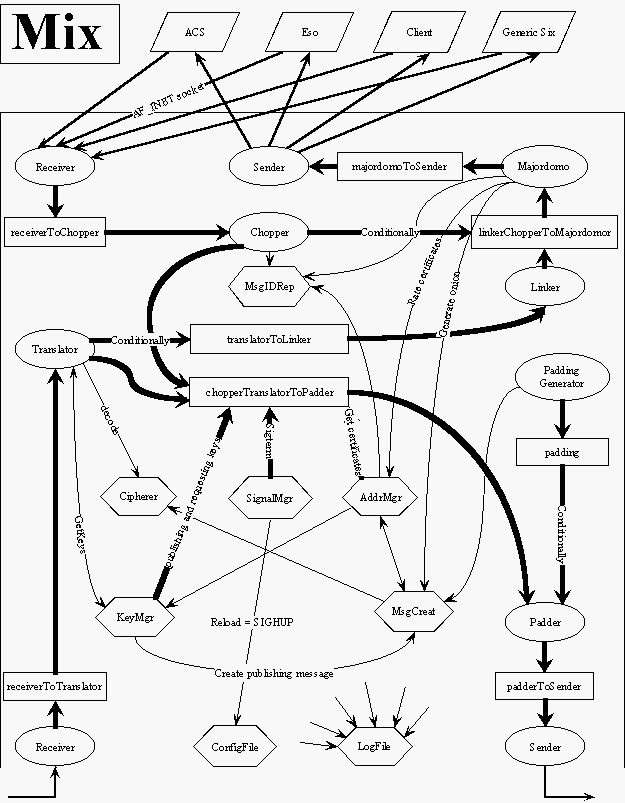 Mix consists of static and dynamic objects. Dynami objects have a special
method, called ::Run(). This method is executed in a separate thread. Static
objects have no such method, just provides some services to another objects.
Messages processed by Mix are moving along several ways inside of Mix. These
ways create 2 main loops. Message that is just forwarded by Mix is receiving
from the Net by Receiver. Translator then gets it and finds out that the
message is going to be sent to the next Mix. Translator then puts it into the
queue leading to Padder. Padder resends it to Sender. Sender is the last
objects in this way, it sends the message to the Net. This situation is just
due to making enemy confused where the message is. The second situation is one
that Mix is the very receiver of the message. In this case, the message is
received by Receiver, processed by Translator and resent to Linker. Linker
waits for all chunks that makes the message and than the whole message is
forwarded to Majordomo. Majordomo decides what to do with the message next. If
the message is for a Six above this Mix, message is resent to Sender. When Six
wants to send a message, he sends the whole message to "upper" Receiver in Mix.
Chopper chops the whole (unlimited in length) message into fixed sized chunks
(Chopper uses MessageCreator for creating fixed messages from chunks) and sends
the cooked messages to Padder. Padder mixes these messages with fake messages
(traffic padding) and forwards messages to Sender. Messages that are to be
processed by Mix (eg. certificates creation) are managed byMajordomo.
--------------------------------------------------------------------------------
12.2.1.3. Implementation of Mix
--------------------------------------------------------------------------------
12.2.1.3.1. Mix
Object Mix is the main object of the whole Mix server. This objects have
several objects that implements Mix's functionality. Mix as an object just
creates these objects and runs Run methods in separate threads.
--------------------------------------------------------------------------------
12.2.1.3.2. Translator
Translator together with MessageCreator object implements the core of onion
routing algorithm (for more information on this topic see Onion routing).
Translator receives messages from Receiver object and removes the top peel.
The peel removing is accomplished this way: first Translator decodes
symetric key (with Mix's private key) found in Recipient field in the
message and this symetric key is then used for decrypting the rest of the
message header. In header, there is another symetric key that is used for
decrypting the message body. Now Translator has enough information about
where the message is about to go next.
Because of the fact that it is needed to decrypt the symetric key as a
first action and the that is used to decrypt it is Mix's private RSA key,
nobody can get information about the next hop but Mix.
From information decrypted from the message body Translator can decide
whether to route the message to the next hop or whether the message is for
some Six above this local Mix.
If the message is about to go to the next hop, before the message routing
it is needed to encrypt the message body with a symetric key that was found
in the decrypted header. The body now doesn't look like the body that came
and it is much harder to trace it (header is also changed).
Translator is one of the objects that implement important functions of Mix
as a communication server, ie. making traffic analysis much harder.
Decrypting of the message is fullfiled with help of KeyManager and
Cipherer.
--------------------------------------------------------------------------------
12.2.1.3.3. Chopper
Processes all the messages from its input queue (from Receiver). If the
message is destined for the local Mix, it is most probably some kind of
request from Six and so the message is passed to Majordomo that will takecare
of it. If it is a request for sending data ,then chopper chops the message
into uniform chunks - padding the last one if necessary. These chunks are then
concatenated with headers that contain info about total number of chunks,
chunk number, message length and message ID. These headers are necessary for
reconstructing the original message at destination address.
MessageCreator then prepends onion before chunk and adds some additional
peels. Now is preparation of chunks finished and all the data can be passed to
Padder.
Mix consists of static and dynamic objects. Dynami objects have a special
method, called ::Run(). This method is executed in a separate thread. Static
objects have no such method, just provides some services to another objects.
Messages processed by Mix are moving along several ways inside of Mix. These
ways create 2 main loops. Message that is just forwarded by Mix is receiving
from the Net by Receiver. Translator then gets it and finds out that the
message is going to be sent to the next Mix. Translator then puts it into the
queue leading to Padder. Padder resends it to Sender. Sender is the last
objects in this way, it sends the message to the Net. This situation is just
due to making enemy confused where the message is. The second situation is one
that Mix is the very receiver of the message. In this case, the message is
received by Receiver, processed by Translator and resent to Linker. Linker
waits for all chunks that makes the message and than the whole message is
forwarded to Majordomo. Majordomo decides what to do with the message next. If
the message is for a Six above this Mix, message is resent to Sender. When Six
wants to send a message, he sends the whole message to "upper" Receiver in Mix.
Chopper chops the whole (unlimited in length) message into fixed sized chunks
(Chopper uses MessageCreator for creating fixed messages from chunks) and sends
the cooked messages to Padder. Padder mixes these messages with fake messages
(traffic padding) and forwards messages to Sender. Messages that are to be
processed by Mix (eg. certificates creation) are managed byMajordomo.
--------------------------------------------------------------------------------
12.2.1.3. Implementation of Mix
--------------------------------------------------------------------------------
12.2.1.3.1. Mix
Object Mix is the main object of the whole Mix server. This objects have
several objects that implements Mix's functionality. Mix as an object just
creates these objects and runs Run methods in separate threads.
--------------------------------------------------------------------------------
12.2.1.3.2. Translator
Translator together with MessageCreator object implements the core of onion
routing algorithm (for more information on this topic see Onion routing).
Translator receives messages from Receiver object and removes the top peel.
The peel removing is accomplished this way: first Translator decodes
symetric key (with Mix's private key) found in Recipient field in the
message and this symetric key is then used for decrypting the rest of the
message header. In header, there is another symetric key that is used for
decrypting the message body. Now Translator has enough information about
where the message is about to go next.
Because of the fact that it is needed to decrypt the symetric key as a
first action and the that is used to decrypt it is Mix's private RSA key,
nobody can get information about the next hop but Mix.
From information decrypted from the message body Translator can decide
whether to route the message to the next hop or whether the message is for
some Six above this local Mix.
If the message is about to go to the next hop, before the message routing
it is needed to encrypt the message body with a symetric key that was found
in the decrypted header. The body now doesn't look like the body that came
and it is much harder to trace it (header is also changed).
Translator is one of the objects that implement important functions of Mix
as a communication server, ie. making traffic analysis much harder.
Decrypting of the message is fullfiled with help of KeyManager and
Cipherer.
--------------------------------------------------------------------------------
12.2.1.3.3. Chopper
Processes all the messages from its input queue (from Receiver). If the
message is destined for the local Mix, it is most probably some kind of
request from Six and so the message is passed to Majordomo that will takecare
of it. If it is a request for sending data ,then chopper chops the message
into uniform chunks - padding the last one if necessary. These chunks are then
concatenated with headers that contain info about total number of chunks,
chunk number, message length and message ID. These headers are necessary for
reconstructing the original message at destination address.
MessageCreator then prepends onion before chunk and adds some additional
peels. Now is preparation of chunks finished and all the data can be passed to
Padder.
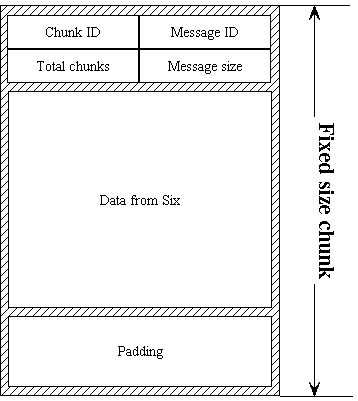 So that the additional headers are not visible in the middle of path they are
end to end encrypted using an additional asymetric key - see MessageCreator.
Optimal chunk size is not known as well as header length.
--------------------------------------------------------------------------------
12.2.1.3.4. Linker
Processes messages that it gets from Translator and inserts them into its
internal structures. These messages are in fact blocks made by chopper. Linker
uses the additional headers in chunks to collect all chunks belonging to one
message and reconstruct the original message. The final message is then passed
to Majordomo.
Linker should implement some kind of timeout to discard messages that are not
complete and some chunks probably got lost. Else it would eventually fill with
incomplete message.
--------------------------------------------------------------------------------
12.2.1.3.5. Padder
Together with PaddingGenerator they implement a strategy for traffic padding
and traffic shaping. We tried to implement some strategy into these objects
but it did not work so it is not used by now. Maybe it would be a good idea
to try to use a tool like dummy net to shape the traffic to some average - the
peaks being cut would then fill the gaps.
--------------------------------------------------------------------------------
12.2.1.3.6. KeyManager
Takes care of keys of the local Mix. Generates new keys. Expiration of keys is
not implemented yet. Cooperates with AddressManager.
--------------------------------------------------------------------------------
12.2.1.3.7. MessageCreator
MessageCreator is the object that can build whole messages or onions only.
AddressManager makes use of his service for creation of messages used for
certificate publications, Padder cooperates with MessageCreator in creating
padding traffic, Chopper asks him for creating of messages from so called
"chunks", that Chopper chops from the data of any length (that data that
is about to send by Six).
--------------------------------------------------------------------------------
12.2.1.4. Onion creation
Each peel of an onion has to be able to open only with decrypting of a
symetric key that was inserted in the peel above the current one. For
decryption one has to use Mix's private asymetric key that is in turn in
the chain of Mixes creating the secure channel. Ie. that during the
creation of the onion we have to know all the certificates for Mixes that
will be on the way. All peels are during the addition of the next one
decrypted. This way, Mix anywhere in the chain can find out just the next
Mix on the way. This solution to traffic analysis problem is called Onion
routing. See Figure somewhere else (###).
Before we begin to build an onion, to the inner peel we have to save all
symetric keys that will be used for building the onion. In this bottom peel
there is also saved a freshly generated private key. The public key form
the same pair is put on the top of built onion. See next para for more
information
--------------------------------------------------------------------------------
12.2.1.5. Message creation
Creation of messages has two parts:
- during the first phase Mix has to add some peels on the top of an onion
that is given by Six. Adding some peels is not neccesary, of course. But
it is needed if Six wants to feel secure. For more info, see
Identification of objects. Public key that is on the top of the onion we
save aside, Mix will use it for processing of given data.
- the second phase is processing of data that is given by Six to be sent
to the subject identified by the onion. As it was already said somewhere,
body of the message is encrypted in each Mix that is on the way. The
reason is that we need the message to look like different message as it
goes out of the Mix. See next para for more info.
So that the additional headers are not visible in the middle of path they are
end to end encrypted using an additional asymetric key - see MessageCreator.
Optimal chunk size is not known as well as header length.
--------------------------------------------------------------------------------
12.2.1.3.4. Linker
Processes messages that it gets from Translator and inserts them into its
internal structures. These messages are in fact blocks made by chopper. Linker
uses the additional headers in chunks to collect all chunks belonging to one
message and reconstruct the original message. The final message is then passed
to Majordomo.
Linker should implement some kind of timeout to discard messages that are not
complete and some chunks probably got lost. Else it would eventually fill with
incomplete message.
--------------------------------------------------------------------------------
12.2.1.3.5. Padder
Together with PaddingGenerator they implement a strategy for traffic padding
and traffic shaping. We tried to implement some strategy into these objects
but it did not work so it is not used by now. Maybe it would be a good idea
to try to use a tool like dummy net to shape the traffic to some average - the
peaks being cut would then fill the gaps.
--------------------------------------------------------------------------------
12.2.1.3.6. KeyManager
Takes care of keys of the local Mix. Generates new keys. Expiration of keys is
not implemented yet. Cooperates with AddressManager.
--------------------------------------------------------------------------------
12.2.1.3.7. MessageCreator
MessageCreator is the object that can build whole messages or onions only.
AddressManager makes use of his service for creation of messages used for
certificate publications, Padder cooperates with MessageCreator in creating
padding traffic, Chopper asks him for creating of messages from so called
"chunks", that Chopper chops from the data of any length (that data that
is about to send by Six).
--------------------------------------------------------------------------------
12.2.1.4. Onion creation
Each peel of an onion has to be able to open only with decrypting of a
symetric key that was inserted in the peel above the current one. For
decryption one has to use Mix's private asymetric key that is in turn in
the chain of Mixes creating the secure channel. Ie. that during the
creation of the onion we have to know all the certificates for Mixes that
will be on the way. All peels are during the addition of the next one
decrypted. This way, Mix anywhere in the chain can find out just the next
Mix on the way. This solution to traffic analysis problem is called Onion
routing. See Figure somewhere else (###).
Before we begin to build an onion, to the inner peel we have to save all
symetric keys that will be used for building the onion. In this bottom peel
there is also saved a freshly generated private key. The public key form
the same pair is put on the top of built onion. See next para for more
information
--------------------------------------------------------------------------------
12.2.1.5. Message creation
Creation of messages has two parts:
- during the first phase Mix has to add some peels on the top of an onion
that is given by Six. Adding some peels is not neccesary, of course. But
it is needed if Six wants to feel secure. For more info, see
Identification of objects. Public key that is on the top of the onion we
save aside, Mix will use it for processing of given data.
- the second phase is processing of data that is given by Six to be sent
to the subject identified by the onion. As it was already said somewhere,
body of the message is encrypted in each Mix that is on the way. The
reason is that we need the message to look like different message as it
goes out of the Mix. See next para for more info.
 --------------------------------------------------------------------------------
12.2.1.6. Data processing
When a Six sends data using an onion as a receiver address, Six can ask Mix for
adding some layers on the top of the onion. Mix generates the same number of
symetric keys as is the number of peels that are going to be added. The data
part of a chunk is decrypted with all there keys. These keys are then included
in the chunk's header (each key in one peel). When the chunk (fixed message)
goes through the chain of Mixes, these keys will be used for encrypting the
data part. Algorithms for symetric encoding implie that it wouldn't be safe to
decrypt the data first (ie. to multiply decrypt plain data). These data needn't
be random and from decrypted data that wasn't random we can get the plain data
easily. From the information given here, in the middle of the chain of Mixes
the data are in the plain form (ie. the form that was given by Six). During the
second part of the chain, the data part is still encrypted in each Mix, so when
the chunk comes to the last Mix, the data part is multiply encrypted with
symetric keys that was previously inserted into the lowest layer of the onion
(see Creation of onions). This implies that is is easy for the last Mix to get
the plain data (after using the private asymetric key that was also found in
the bottom layer). For further information, see section describing Translator
object.
MessageCreator is the main objects that is involved in algorithm of onion
routing. He creates messages in the way that makes enemy confused about the
real movement of messages.
--------------------------------------------------------------------------------
12.2.2. Six
Into the design of the Eternity Service we incorporated the possibility to
connect any server, which is communicating according to a certain protocol,
to the net of safely communicating Mixes. A core of such a server was
implemented and is called Six. Eso, Bank and Client are currently
implemented using this core, which encapsulates creation of basic threads
of a server and methods that serve messages coming from underlying Mix.
--------------------------------------------------------------------------------
12.2.1.6. Data processing
When a Six sends data using an onion as a receiver address, Six can ask Mix for
adding some layers on the top of the onion. Mix generates the same number of
symetric keys as is the number of peels that are going to be added. The data
part of a chunk is decrypted with all there keys. These keys are then included
in the chunk's header (each key in one peel). When the chunk (fixed message)
goes through the chain of Mixes, these keys will be used for encrypting the
data part. Algorithms for symetric encoding implie that it wouldn't be safe to
decrypt the data first (ie. to multiply decrypt plain data). These data needn't
be random and from decrypted data that wasn't random we can get the plain data
easily. From the information given here, in the middle of the chain of Mixes
the data are in the plain form (ie. the form that was given by Six). During the
second part of the chain, the data part is still encrypted in each Mix, so when
the chunk comes to the last Mix, the data part is multiply encrypted with
symetric keys that was previously inserted into the lowest layer of the onion
(see Creation of onions). This implies that is is easy for the last Mix to get
the plain data (after using the private asymetric key that was also found in
the bottom layer). For further information, see section describing Translator
object.
MessageCreator is the main objects that is involved in algorithm of onion
routing. He creates messages in the way that makes enemy confused about the
real movement of messages.
--------------------------------------------------------------------------------
12.2.2. Six
Into the design of the Eternity Service we incorporated the possibility to
connect any server, which is communicating according to a certain protocol,
to the net of safely communicating Mixes. A core of such a server was
implemented and is called Six. Eso, Bank and Client are currently
implemented using this core, which encapsulates creation of basic threads
of a server and methods that serve messages coming from underlying Mix.
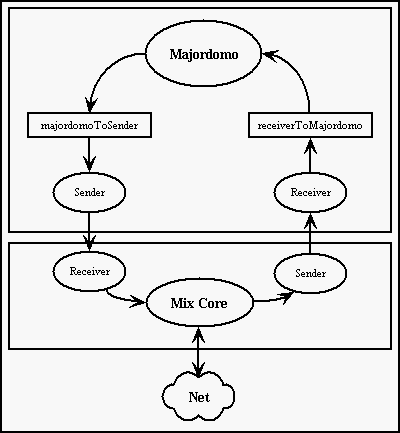 Six includes these threads:
- Receiver
- Majordomo
- Sender
Receiver gets messages from Mix through a socket, which means that Six and
underlying Mix can be run on different computers. Majordomo pareses and
serves incoming messages and Sender is responsible for sending messages
generated by Majordomo through a socket to Mix. Queues are used to
transfer messages among Receiver, Majordomo and Sender.
The sceleton of Majordomo in Six takes care about this communication basics
with Mix:
- asks Mix to generate an onion and calls an Six's abstract method to generate
new access certificate
- asks Mix for access certificates of other Sixes and calls an Six's abstract
method to take care of them somehow
- from Mix it receives a data message sent by another Six
- for Mix it prepares a message to be sent to another Six
Communication among Sixes is always secret because of our safety
requirements. Every single message is encrypted with a public key which is
a part of the recepient's access certificate. Therefor it is needed to
encrypt all messages of Six->Six type which are going to be distibuted into
the Service this way. Six Messages received by another Six must be than
decrypted by appropriate secret key which makes a key pair with public key
from access certificate the message was sent to. Both these operations are
supported in SixMajordomo. The incoming messages decrypting method is
defined as abstract due to differences in secret key storage algorithms in
different Sixes.
As it was mentioned above, one of the key features Mix does for Six is that
it realizes all communication with the whole Eternity Service. An Eso
administrator does not take care about the way messages are sent by Mix,
and on the other hand Mix does not care about the contents of messages it
is asked to send. The SixMajordomo's task is to prepare a command for Mix
that consists of data to be sent and of an onion (which should be
understood as a generic address) data should be sent to.
Six is easily configurable by its configuration file, which name is given
to Six in its constructor. Configuratin file is described in section
###SpolecneObjekty. There are data necessary for a Six to run in the
configuration file, such as:
- name of a Six,
- IP address and incoming and outgoing port of an underlying Mix,
- path to a directory where Six's specific persistent data should be stored.
The name of a configuration file is given to Six as a parameter on a
command line.
To simplify interaction among objects that are parts of Six's descendants
we implemented their ancestor - SixOffspring, which only stores a pointer
to its parental Six. Thanks to this pointer all these objects can call each
other's public methods.
Six is easily configurable core of all executive servers, is capable of
receiving and sending messages from and to Mix and thus from and to
surrounding Service. To implement new executive servers that could
transparently use the principals of anonymous communication through a net
of Mixes means to override and/or add characteristic messages serving
methods in Majordomo.
--------------------------------------------------------------------------------
12.2.2.1. Eso
--------------------------------------------------------------------------------
12.2.2.1.1. Functions of Eso
The main function of an Eso is safe saving of files. It should be done in a
way that even the administrator of the server doesn't know the contents of
files saved on the Eso.
Along with this feature the files must be accessible for the users of Eternity
service. The Eso must be able to search through the database of files and
send back requested data. Therefore each file is saved together with keywords
that are used in requests for search in the Service.
As a motivation for the administrators to run Eternity servers a mechanism of
paying for stored fiiles is proposed. Eso must be able to send a request for
pay for stored files. Again this must be done in a way that the money is sent
only to a server who really stores a file (see Protocols section).
Because all files are stored on Eso only for a certain time, the time
synchronization mechanism must be implemented. Without this feature the
easiest way to force Eso to delete a document would be to move its clock.
--------------------------------------------------------------------------------
12.2.2.1.2. Architecture of Eso
Six includes these threads:
- Receiver
- Majordomo
- Sender
Receiver gets messages from Mix through a socket, which means that Six and
underlying Mix can be run on different computers. Majordomo pareses and
serves incoming messages and Sender is responsible for sending messages
generated by Majordomo through a socket to Mix. Queues are used to
transfer messages among Receiver, Majordomo and Sender.
The sceleton of Majordomo in Six takes care about this communication basics
with Mix:
- asks Mix to generate an onion and calls an Six's abstract method to generate
new access certificate
- asks Mix for access certificates of other Sixes and calls an Six's abstract
method to take care of them somehow
- from Mix it receives a data message sent by another Six
- for Mix it prepares a message to be sent to another Six
Communication among Sixes is always secret because of our safety
requirements. Every single message is encrypted with a public key which is
a part of the recepient's access certificate. Therefor it is needed to
encrypt all messages of Six->Six type which are going to be distibuted into
the Service this way. Six Messages received by another Six must be than
decrypted by appropriate secret key which makes a key pair with public key
from access certificate the message was sent to. Both these operations are
supported in SixMajordomo. The incoming messages decrypting method is
defined as abstract due to differences in secret key storage algorithms in
different Sixes.
As it was mentioned above, one of the key features Mix does for Six is that
it realizes all communication with the whole Eternity Service. An Eso
administrator does not take care about the way messages are sent by Mix,
and on the other hand Mix does not care about the contents of messages it
is asked to send. The SixMajordomo's task is to prepare a command for Mix
that consists of data to be sent and of an onion (which should be
understood as a generic address) data should be sent to.
Six is easily configurable by its configuration file, which name is given
to Six in its constructor. Configuratin file is described in section
###SpolecneObjekty. There are data necessary for a Six to run in the
configuration file, such as:
- name of a Six,
- IP address and incoming and outgoing port of an underlying Mix,
- path to a directory where Six's specific persistent data should be stored.
The name of a configuration file is given to Six as a parameter on a
command line.
To simplify interaction among objects that are parts of Six's descendants
we implemented their ancestor - SixOffspring, which only stores a pointer
to its parental Six. Thanks to this pointer all these objects can call each
other's public methods.
Six is easily configurable core of all executive servers, is capable of
receiving and sending messages from and to Mix and thus from and to
surrounding Service. To implement new executive servers that could
transparently use the principals of anonymous communication through a net
of Mixes means to override and/or add characteristic messages serving
methods in Majordomo.
--------------------------------------------------------------------------------
12.2.2.1. Eso
--------------------------------------------------------------------------------
12.2.2.1.1. Functions of Eso
The main function of an Eso is safe saving of files. It should be done in a
way that even the administrator of the server doesn't know the contents of
files saved on the Eso.
Along with this feature the files must be accessible for the users of Eternity
service. The Eso must be able to search through the database of files and
send back requested data. Therefore each file is saved together with keywords
that are used in requests for search in the Service.
As a motivation for the administrators to run Eternity servers a mechanism of
paying for stored fiiles is proposed. Eso must be able to send a request for
pay for stored files. Again this must be done in a way that the money is sent
only to a server who really stores a file (see Protocols section).
Because all files are stored on Eso only for a certain time, the time
synchronization mechanism must be implemented. Without this feature the
easiest way to force Eso to delete a document would be to move its clock.
--------------------------------------------------------------------------------
12.2.2.1.2. Architecture of Eso
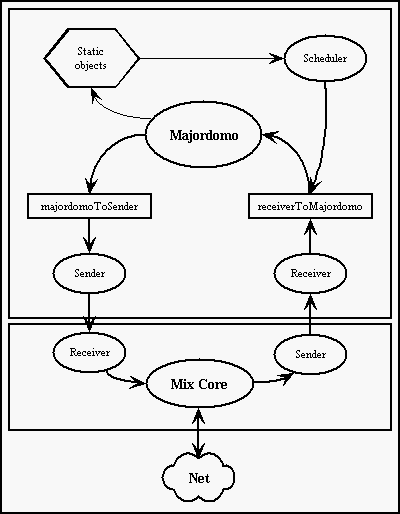 Eso has a role of Six in the Service. The basic function of Six are extended
with functions that serve the messages in the Eso-Client, Eso-Eso and Eso-Bank
communication. The thread for generating parametrized timeouts is added. This
thread generates timeouts, that are ordered by other objects while serving
messages.
All operations done over the incoming messages are quite simple and most of the
time is spent on ciphering that is realized by a synchronnous device (TCB).
That's why even our realization of message serving is done in a synchronnous
way.
--------------------------------------------------------------------------------
12.2.2.1.3. Implementation of Eso
Eso uses the basic functions inherited from Six. The Mix-Six incoming commands
are served "automatically" - in Six. The messages from other Sixes are served
in methods of Eso Majordomo using the static objects of Six. The timeout
messages from Scheduler, that are also put to the input message queue of Six,
are served in Majordomo too. The structure of the messages comming from
Service to each Six is compulsory and is described in Protocols section. Eso
doesn't serve messages that don't have this structure (ignores them).
Description of the classes used in implementatiion of Eso follows.
--------------------------------------------------------------------------------
12.2.2.1.4. Objects of type ACManager
Eso includes several objects of type ACManager. Each of them controls a table
of access certificates of one type. The main functions of ACManagers are
- inserting new certificates into the table
- returning requested number of certificates
- deletes expired certificates (each certificate has an expiration date)
- saves information about the optimal (minimum and maximum) number of
certificates
- returns information about how many certificates are missing to optimal state
- saves information about how often to test the number of non-expired
certificates
None of the ACManager generates the certificates of the Eso. These are generated
in Majordomo methods.
--------------------------------------------------------------------------------
12.2.2.1.3.2. Allocator
Allocator is used every time a request for storage arrives to Eso. It decides
whether Eso will agree or disagree with file storage. Current implemetation of
Allocator simply tries to allocate requested space on a disk and if succesfull
it agrees with the request otherwise it refuses to store the file.
All information about allocations processed is kept in a table, which has ID
of a transaction, in which allocation was requested, as a primary key.
If Eso does not receive the file within certain time period, then Allocator is
called to free allocated space. If Eso receives the file it is waiting for,
Allocator is asked whether there is an valid allocation for file it received.
--------------------------------------------------------------------------------
12.2.2.1.3.3 Banker
This class manages all activities geared with payments for data storage:
- generates payment plans
- manages tables of payments and "currently carried out" payments
While the Eso store the file the Banker registers important information about
payments. These will be used in data ownership prooving in the date of the
payment.
The Banker communicates directly with the Scheduler. It is setting timeouts,
which will inform the Banker that it is time for asking the Bank for money.
Than it provides communication with the Bank.
--------------------------------------------------------------------------------
12.2.2.1.3.4. Eso
This class encapsulates the main functionality of Eso. As a Six descendant
it runs all necessary threads and creates all static objects as Allocator,
Banker, Finder, etc. Because it is derived from Six, it is assigned a
configuration file with specific information. This file can be reached from
all objects that are owned by Eso (such as Allocator, Banker, ...) and that
where derived from SixOffspring (see ###Six).
--------------------------------------------------------------------------------
12.2.2.1.3.5. Finder
Finder is used for searchhing and downloading files.
It is a very simple object encapsulsating two tables:
- forward table (where to send file found on other Eso in a tree search)
- reply table (what ffids were already sent - used for cutting the serch tree
through)
The tree search algorithm is described in Protocols section.
Note:
Finder as well as the methods in Majordomo using finder are completely
implemented, but not fully tested (we didn't test the search tree).
--------------------------------------------------------------------------------
12.2.2.1.3.6. Scheduler
Task of scheduler is setting of timeouts and sending messages to the queue
between Receiver and Majordom when timeout is expired. Scheduler can send some
information with expired timeout.
Expiration time is possible to set absolutely (accurate time) or relatively
(time from actual time to expiration).
By this mechanism is implemented starting of events which is periodical (for
example time sychronization) or ending of operations that have time limit or
that can be timeless.
Important feature of timeout is possibility to add information which is send
to the queue between Receiver and Majordom. Parameters of timeout's setting:
- time of expiration - absolute or relative
- command - identification of timeout's type
- data - added information
Setting of timeout is implemented by inserting the record into the
sorted table. This table is sorted by expiration of timeout and
timeout which expired first is also first in the table. Searching
expired timeouts is realized by searching table in timeless cycle.
This cycle runs in stand-alone thread and always is gone to sleep
for some time because no operation is time critical.
--------------------------------------------------------------------------------
12.2.2.1.3.7. TCBWrapper, SWTCBWrapper
TCBWrapper is an abstract class telling what methods must provide a concrete
TCB implementation. In our implementation of Eso there is only SW emulation of
TCB device so we needed to implement a descendant of TCBWrapper -
SWTCBWrapper. SWTCBWrapper maintains a table of stored files and a table of
certificate keys. Both tables are kept encrypted with symetric keys. These
table-keys are part of hierarchical key management and they can be obtained
only having the master key of the hierarchy.
All this information must not be reachable outside TCB, which is (thanks to
hierarchical key management) reduced to simple request that the master key
must not be reachable outside TCB. But when there is no TCB device in our
implementation of Eso, we keep the master key as a private attribute in
SWTCBWrapper. But because there is no special hardware to store the master key
in, we simply store it on a disk, which is not sufficient.
TCBWrapper must provide these services:
- store a file
- find files and return their headers (describing what files were found)
- get file (decrypting it with TCB private key and encrypting it with
Client's public key all that in one step)
- generate access certificate keys
- decrypt with access certificate's private key
See ###tcb_diskuze how we designed what and how HWTCBWrapper could work.
--------------------------------------------------------------------------------
12.2.2.1.3.8. TimeSynchronizer
This Eso's object compares system time and time of others Esos periodically.
The problem of found out an accurate time is written in detail in section
--------------------------------------------------------------------------------
12.2.2.1.3.9. Transaction Manager
Though there is a lot of records in Eso, that are dependent one
upon the other, we identified a need to keep all those records
consistent. There are data valid only for certain time in Eso,
which need a message from Scheduler telling that they are expired.
If Eso is not correctly exited, it could happen that e.g. data are
stored but there would be no timeout set for their expiration, so
these data will never be released.
Both problems can be solved by TransactionManager. TransactionManager writes
transaction ID to its log on every start of a transaction (which means the
beginning of handling received message) and on every end as well. So when Eso
is started it is sufficient to check for not ended transactions which are then
rolled back. It means TransactionManager calls a Rollback method of all
classes that has registered themselves as Rollbackcable (with a method of
TransactionManager).
Current implementation does not parse the transaction log to find out what
transaction have not been ended properly.
--------------------------------------------------------------------------------
12.2.2.1.4. Discussion, alternative solutions
--------------------------------------------------------------------------------
12.2.2.1.4.1. TCB
We made a proposal of HWTCBWrapper communication with HW TCB device, which is
able to work with partial results:
Eso has a role of Six in the Service. The basic function of Six are extended
with functions that serve the messages in the Eso-Client, Eso-Eso and Eso-Bank
communication. The thread for generating parametrized timeouts is added. This
thread generates timeouts, that are ordered by other objects while serving
messages.
All operations done over the incoming messages are quite simple and most of the
time is spent on ciphering that is realized by a synchronnous device (TCB).
That's why even our realization of message serving is done in a synchronnous
way.
--------------------------------------------------------------------------------
12.2.2.1.3. Implementation of Eso
Eso uses the basic functions inherited from Six. The Mix-Six incoming commands
are served "automatically" - in Six. The messages from other Sixes are served
in methods of Eso Majordomo using the static objects of Six. The timeout
messages from Scheduler, that are also put to the input message queue of Six,
are served in Majordomo too. The structure of the messages comming from
Service to each Six is compulsory and is described in Protocols section. Eso
doesn't serve messages that don't have this structure (ignores them).
Description of the classes used in implementatiion of Eso follows.
--------------------------------------------------------------------------------
12.2.2.1.4. Objects of type ACManager
Eso includes several objects of type ACManager. Each of them controls a table
of access certificates of one type. The main functions of ACManagers are
- inserting new certificates into the table
- returning requested number of certificates
- deletes expired certificates (each certificate has an expiration date)
- saves information about the optimal (minimum and maximum) number of
certificates
- returns information about how many certificates are missing to optimal state
- saves information about how often to test the number of non-expired
certificates
None of the ACManager generates the certificates of the Eso. These are generated
in Majordomo methods.
--------------------------------------------------------------------------------
12.2.2.1.3.2. Allocator
Allocator is used every time a request for storage arrives to Eso. It decides
whether Eso will agree or disagree with file storage. Current implemetation of
Allocator simply tries to allocate requested space on a disk and if succesfull
it agrees with the request otherwise it refuses to store the file.
All information about allocations processed is kept in a table, which has ID
of a transaction, in which allocation was requested, as a primary key.
If Eso does not receive the file within certain time period, then Allocator is
called to free allocated space. If Eso receives the file it is waiting for,
Allocator is asked whether there is an valid allocation for file it received.
--------------------------------------------------------------------------------
12.2.2.1.3.3 Banker
This class manages all activities geared with payments for data storage:
- generates payment plans
- manages tables of payments and "currently carried out" payments
While the Eso store the file the Banker registers important information about
payments. These will be used in data ownership prooving in the date of the
payment.
The Banker communicates directly with the Scheduler. It is setting timeouts,
which will inform the Banker that it is time for asking the Bank for money.
Than it provides communication with the Bank.
--------------------------------------------------------------------------------
12.2.2.1.3.4. Eso
This class encapsulates the main functionality of Eso. As a Six descendant
it runs all necessary threads and creates all static objects as Allocator,
Banker, Finder, etc. Because it is derived from Six, it is assigned a
configuration file with specific information. This file can be reached from
all objects that are owned by Eso (such as Allocator, Banker, ...) and that
where derived from SixOffspring (see ###Six).
--------------------------------------------------------------------------------
12.2.2.1.3.5. Finder
Finder is used for searchhing and downloading files.
It is a very simple object encapsulsating two tables:
- forward table (where to send file found on other Eso in a tree search)
- reply table (what ffids were already sent - used for cutting the serch tree
through)
The tree search algorithm is described in Protocols section.
Note:
Finder as well as the methods in Majordomo using finder are completely
implemented, but not fully tested (we didn't test the search tree).
--------------------------------------------------------------------------------
12.2.2.1.3.6. Scheduler
Task of scheduler is setting of timeouts and sending messages to the queue
between Receiver and Majordom when timeout is expired. Scheduler can send some
information with expired timeout.
Expiration time is possible to set absolutely (accurate time) or relatively
(time from actual time to expiration).
By this mechanism is implemented starting of events which is periodical (for
example time sychronization) or ending of operations that have time limit or
that can be timeless.
Important feature of timeout is possibility to add information which is send
to the queue between Receiver and Majordom. Parameters of timeout's setting:
- time of expiration - absolute or relative
- command - identification of timeout's type
- data - added information
Setting of timeout is implemented by inserting the record into the
sorted table. This table is sorted by expiration of timeout and
timeout which expired first is also first in the table. Searching
expired timeouts is realized by searching table in timeless cycle.
This cycle runs in stand-alone thread and always is gone to sleep
for some time because no operation is time critical.
--------------------------------------------------------------------------------
12.2.2.1.3.7. TCBWrapper, SWTCBWrapper
TCBWrapper is an abstract class telling what methods must provide a concrete
TCB implementation. In our implementation of Eso there is only SW emulation of
TCB device so we needed to implement a descendant of TCBWrapper -
SWTCBWrapper. SWTCBWrapper maintains a table of stored files and a table of
certificate keys. Both tables are kept encrypted with symetric keys. These
table-keys are part of hierarchical key management and they can be obtained
only having the master key of the hierarchy.
All this information must not be reachable outside TCB, which is (thanks to
hierarchical key management) reduced to simple request that the master key
must not be reachable outside TCB. But when there is no TCB device in our
implementation of Eso, we keep the master key as a private attribute in
SWTCBWrapper. But because there is no special hardware to store the master key
in, we simply store it on a disk, which is not sufficient.
TCBWrapper must provide these services:
- store a file
- find files and return their headers (describing what files were found)
- get file (decrypting it with TCB private key and encrypting it with
Client's public key all that in one step)
- generate access certificate keys
- decrypt with access certificate's private key
See ###tcb_diskuze how we designed what and how HWTCBWrapper could work.
--------------------------------------------------------------------------------
12.2.2.1.3.8. TimeSynchronizer
This Eso's object compares system time and time of others Esos periodically.
The problem of found out an accurate time is written in detail in section
--------------------------------------------------------------------------------
12.2.2.1.3.9. Transaction Manager
Though there is a lot of records in Eso, that are dependent one
upon the other, we identified a need to keep all those records
consistent. There are data valid only for certain time in Eso,
which need a message from Scheduler telling that they are expired.
If Eso is not correctly exited, it could happen that e.g. data are
stored but there would be no timeout set for their expiration, so
these data will never be released.
Both problems can be solved by TransactionManager. TransactionManager writes
transaction ID to its log on every start of a transaction (which means the
beginning of handling received message) and on every end as well. So when Eso
is started it is sufficient to check for not ended transactions which are then
rolled back. It means TransactionManager calls a Rollback method of all
classes that has registered themselves as Rollbackcable (with a method of
TransactionManager).
Current implementation does not parse the transaction log to find out what
transaction have not been ended properly.
--------------------------------------------------------------------------------
12.2.2.1.4. Discussion, alternative solutions
--------------------------------------------------------------------------------
12.2.2.1.4.1. TCB
We made a proposal of HWTCBWrapper communication with HW TCB device, which is
able to work with partial results:
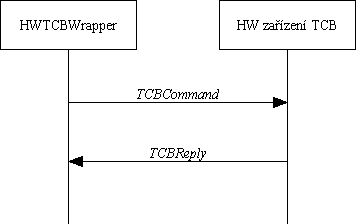 HWTCBWrapper sends to TCB messages of TCBCommand type
TCB returns replies of TCBReply type
TCBCommand is of following structure:
- Command - information for TCB what it is asked for or what can be found in Data field
- Data
Field Command can be one of:
- Initialize - resets HW device
- predefined commands such as SaveFile, DeleteFileByPID - runs a
TCB algorithm which leads to TCBReplies, in which TCB tells what
it needs to get to succesfully finish the required task
- Data - indicates that field Data cares requested data
TCBReply is of following structure:
- Returning - indicates what comes in Data field
- Data - contents described by Returning
- Requesting - data TCB wants to get in the next step
If we want to work with partial results it is needed to distinguish between
IDs that stand for standard (predefined) objects (such as Table of stored
files, Table of keys, etc.) and IDs that stand for partial results. This
takes part in Returning and Requesting fields. To solve this problem it
would be sufficient to divide ID space into two parts: first (e.g. 0-99)
would be reserved for standard objects, second (e.g. >99) for partial
results.
--------------------------------------------------------------------------------
12.2.2.2. Acs
--------------------------------------------------------------------------------
12.2.2.2.1. Function of Acs
Acs is another Six that is running above the Mix (as each Six does). His
function is certificate management. Aside from access certificates of
Eternity servers (Esos), Acs has manage a database of Mix's, Bank's and
and other Acs's certificates. Acs can manage certificates other Sixes (that
are not implemented yet).
We want Acs to be able just serve request for returning some certificates
(type + number is needed in the request) and to serve requests for storing
certificates of Sixs that want to advertise themselves. Acs is the server
that is a gate to Service for all other subjects in Service.
The very first idea was that we make use of an existing WWW server (Apache)
and that Acs would be just a cgi script, that would cooperate with the WWW
server. Because of format of communication and overall architecture of
Service, we finally decided to implement Acs as a standalone Six.
--------------------------------------------------------------------------------
12.2.2.2.2. Architecture of Acs
Architecture of Acs can be explained with the following Figure (###).
HWTCBWrapper sends to TCB messages of TCBCommand type
TCB returns replies of TCBReply type
TCBCommand is of following structure:
- Command - information for TCB what it is asked for or what can be found in Data field
- Data
Field Command can be one of:
- Initialize - resets HW device
- predefined commands such as SaveFile, DeleteFileByPID - runs a
TCB algorithm which leads to TCBReplies, in which TCB tells what
it needs to get to succesfully finish the required task
- Data - indicates that field Data cares requested data
TCBReply is of following structure:
- Returning - indicates what comes in Data field
- Data - contents described by Returning
- Requesting - data TCB wants to get in the next step
If we want to work with partial results it is needed to distinguish between
IDs that stand for standard (predefined) objects (such as Table of stored
files, Table of keys, etc.) and IDs that stand for partial results. This
takes part in Returning and Requesting fields. To solve this problem it
would be sufficient to divide ID space into two parts: first (e.g. 0-99)
would be reserved for standard objects, second (e.g. >99) for partial
results.
--------------------------------------------------------------------------------
12.2.2.2. Acs
--------------------------------------------------------------------------------
12.2.2.2.1. Function of Acs
Acs is another Six that is running above the Mix (as each Six does). His
function is certificate management. Aside from access certificates of
Eternity servers (Esos), Acs has manage a database of Mix's, Bank's and
and other Acs's certificates. Acs can manage certificates other Sixes (that
are not implemented yet).
We want Acs to be able just serve request for returning some certificates
(type + number is needed in the request) and to serve requests for storing
certificates of Sixs that want to advertise themselves. Acs is the server
that is a gate to Service for all other subjects in Service.
The very first idea was that we make use of an existing WWW server (Apache)
and that Acs would be just a cgi script, that would cooperate with the WWW
server. Because of format of communication and overall architecture of
Service, we finally decided to implement Acs as a standalone Six.
--------------------------------------------------------------------------------
12.2.2.2.2. Architecture of Acs
Architecture of Acs can be explained with the following Figure (###).
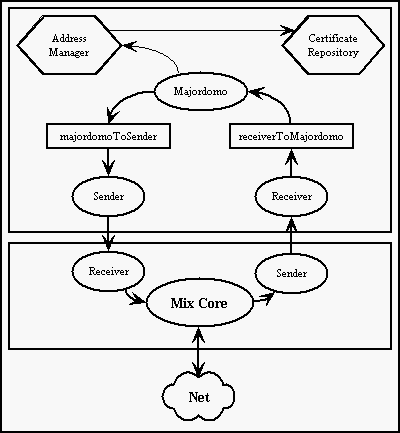 Acs consists of 5 independent parts:
- Sender, generic object that is used in all servers of the Service, Sender
sends messages through the local Mix.
- Receiver, generic object
- Majordomo, this object is a core of Acs. Serves requests from Acs
clients, ie. accepts and stores certificates or returns requested
certificates (stored in Acs database)
- AddressManager, manages certificates in the database. AM is able to store
certificates, search for them and return them.
- CertificateReposity, is called directly by AddressManager, is responsible
for physical storage and physical searching for certificates.
--------------------------------------------------------------------------------
12.2.2.2.3. Implementation of Acs
Sender and Receiver are objects that are the same for all Sixes, their
implementation is explained in the respective section.
Majordomo is a object with a method Majordomo::Run() that is the core of
Majordomo. This method contains neverending loop that is sleeping on the
semaphore telling the number of messages from Receiver. Method servers
requests CMD_PUBLISH_CERTIFICATE and CMD_GET_CERTIFICATES. The formats of
respective messages are in programmer documentation.
CertificateRepository and AddressManager are static objects that are in
this form used already in Mix. AddressManager is laid on the top of
CertificateRepository, that is just a lowlevel tool for physical management
of certificates.
At present, Majordomo doesn't check certificates at the moment when
receiving them neither during the time when certificates are stored on the
disc.
--------------------------------------------------------------------------------
12.2.2.2.4. Discussion, alternative solutions
We decided to implement Acs as a standalone server that communicates with other
servers using a defined protocol. It would be useful to make some kind of web
interface to Acs for administrators that are setting up new servers - for
secure operation of Mixes they need some certificates to start with. Including
these certificates in distribution is not a good idea as the attackers could
focus on the servers included in distribution and the load of these servers
would be really high. Administrator could download some random certificates
from Acs using the web interface - maybe from some Acses and then combine these
packages to make sure he is safe.
By now setting up a new server is not that easy and involves quite a lot of
manual and intelectual work.
--------------------------------------------------------------------------------
12.2.2.2.4.1. Possible attacks against Acs and ways to defend
Acs does not check any certificates by now and as such can be subject to some
attacks. This should be changed before Acs can be more widely used.
Enemy can generate access certificates with invalid addresses and fill so the
Acs and cause a denial of service or fill Acs with certificates of his own
controled Mixes and gain control over majority of traffic. The trust in service
can be damaged badly by propagating invalid information.
Acs can protocet itself using thee techniques:
Check Mix certificates - it can try to send some message using the certificate
and see if the Mix is really functioning. Such message would have to look the
same as all other messages and go from Acs through tested Mix back to Acs. If
it goes through the Mix is OK. If additional Mixes are used then the tested Mix
has no chance to find out if it is a test message or a message passed through
service. Such checks should be performed periodically.
Payment for publishing certificates - this would prevent anybody from flooding
Acs with his own Mixes. This may be useful for certificates, that's
functionality is not possible to check. But paying for publishing Mix
certificates seems to be a little problematic.
Expiration time - Acs can have a maximum period of time for which it is willing
to store certificate regardless of its expiration time.
--------------------------------------------------------------------------------
12.2.2.2.4.2. Certificates maintanace
In case of massive and widespread usage of Service, it would be good to thing
about making usage of an existing database engine. This engine would physically
manage all certificates.
--------------------------------------------------------------------------------
12.2.2.3. Client
Client is a module, that enables the user to upload, download and search for
files including the communication with Bank. Because the Client communicates
in the Service using a local Mix, we implemented it as a descendant of Six.
Client is run always only to execute one operation.
--------------------------------------------------------------------------------
12.2.2.3.1. Functions of Client
Client enables to perform these operations:
- upload of the file on a given number of Esos
- search for file headers according to the mask including keywords of the file
- download of the file according to the unique identificator of the file
Upload of the file has two files. First asks Client Esos for saving file.
Positive responses to these requests are payplans. Client saves them to disk.
Then Client sends file to Esos that agreed. (see Preparing the file for
upload) The file is sent together with keywords and unique identificator.
Search and download are simple functions: Client sends requests to given
number of Esos and waits for annswers.
--------------------------------------------------------------------------------
12.2.2.3.2. Architecture of Client
Client inherits the basic objects of Six (Receiver, Majordomo, Sender) and
adds one more (Banker). Majordomo's method Run is overriden (it is run only as
a batch).
Acs consists of 5 independent parts:
- Sender, generic object that is used in all servers of the Service, Sender
sends messages through the local Mix.
- Receiver, generic object
- Majordomo, this object is a core of Acs. Serves requests from Acs
clients, ie. accepts and stores certificates or returns requested
certificates (stored in Acs database)
- AddressManager, manages certificates in the database. AM is able to store
certificates, search for them and return them.
- CertificateReposity, is called directly by AddressManager, is responsible
for physical storage and physical searching for certificates.
--------------------------------------------------------------------------------
12.2.2.2.3. Implementation of Acs
Sender and Receiver are objects that are the same for all Sixes, their
implementation is explained in the respective section.
Majordomo is a object with a method Majordomo::Run() that is the core of
Majordomo. This method contains neverending loop that is sleeping on the
semaphore telling the number of messages from Receiver. Method servers
requests CMD_PUBLISH_CERTIFICATE and CMD_GET_CERTIFICATES. The formats of
respective messages are in programmer documentation.
CertificateRepository and AddressManager are static objects that are in
this form used already in Mix. AddressManager is laid on the top of
CertificateRepository, that is just a lowlevel tool for physical management
of certificates.
At present, Majordomo doesn't check certificates at the moment when
receiving them neither during the time when certificates are stored on the
disc.
--------------------------------------------------------------------------------
12.2.2.2.4. Discussion, alternative solutions
We decided to implement Acs as a standalone server that communicates with other
servers using a defined protocol. It would be useful to make some kind of web
interface to Acs for administrators that are setting up new servers - for
secure operation of Mixes they need some certificates to start with. Including
these certificates in distribution is not a good idea as the attackers could
focus on the servers included in distribution and the load of these servers
would be really high. Administrator could download some random certificates
from Acs using the web interface - maybe from some Acses and then combine these
packages to make sure he is safe.
By now setting up a new server is not that easy and involves quite a lot of
manual and intelectual work.
--------------------------------------------------------------------------------
12.2.2.2.4.1. Possible attacks against Acs and ways to defend
Acs does not check any certificates by now and as such can be subject to some
attacks. This should be changed before Acs can be more widely used.
Enemy can generate access certificates with invalid addresses and fill so the
Acs and cause a denial of service or fill Acs with certificates of his own
controled Mixes and gain control over majority of traffic. The trust in service
can be damaged badly by propagating invalid information.
Acs can protocet itself using thee techniques:
Check Mix certificates - it can try to send some message using the certificate
and see if the Mix is really functioning. Such message would have to look the
same as all other messages and go from Acs through tested Mix back to Acs. If
it goes through the Mix is OK. If additional Mixes are used then the tested Mix
has no chance to find out if it is a test message or a message passed through
service. Such checks should be performed periodically.
Payment for publishing certificates - this would prevent anybody from flooding
Acs with his own Mixes. This may be useful for certificates, that's
functionality is not possible to check. But paying for publishing Mix
certificates seems to be a little problematic.
Expiration time - Acs can have a maximum period of time for which it is willing
to store certificate regardless of its expiration time.
--------------------------------------------------------------------------------
12.2.2.2.4.2. Certificates maintanace
In case of massive and widespread usage of Service, it would be good to thing
about making usage of an existing database engine. This engine would physically
manage all certificates.
--------------------------------------------------------------------------------
12.2.2.3. Client
Client is a module, that enables the user to upload, download and search for
files including the communication with Bank. Because the Client communicates
in the Service using a local Mix, we implemented it as a descendant of Six.
Client is run always only to execute one operation.
--------------------------------------------------------------------------------
12.2.2.3.1. Functions of Client
Client enables to perform these operations:
- upload of the file on a given number of Esos
- search for file headers according to the mask including keywords of the file
- download of the file according to the unique identificator of the file
Upload of the file has two files. First asks Client Esos for saving file.
Positive responses to these requests are payplans. Client saves them to disk.
Then Client sends file to Esos that agreed. (see Preparing the file for
upload) The file is sent together with keywords and unique identificator.
Search and download are simple functions: Client sends requests to given
number of Esos and waits for annswers.
--------------------------------------------------------------------------------
12.2.2.3.2. Architecture of Client
Client inherits the basic objects of Six (Receiver, Majordomo, Sender) and
adds one more (Banker). Majordomo's method Run is overriden (it is run only as
a batch).
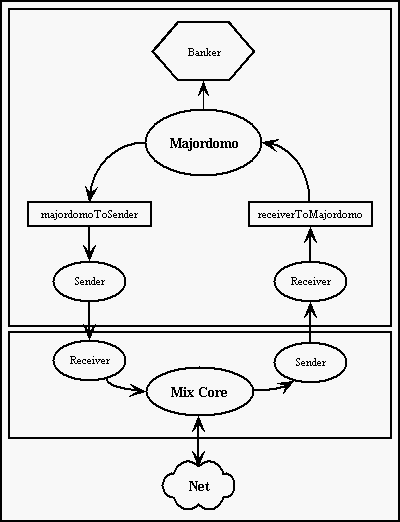 --------------------------------------------------------------------------------
12.2.2.3.3. Implementation of Client
--------------------------------------------------------------------------------
12.2.2.3.3.1. Majordomo
Object using SixMajordomo with added methods for upload, download and search,
overriden method Run and many test methods (now mostly not functional).
--------------------------------------------------------------------------------
12.2.2.3.3.2 Banker
When storing file this object manages payment plans and prepares information
for the Bank.
--------------------------------------------------------------------------------
12.2.2.3.3.3. Summary
This is "minimal functional version of Client". Three basic functions (upload,
download, search) are implemented. It is run from the command line. The
functions for communication with Bank are neither implemented nor tested.
--------------------------------------------------------------------------------
12.2.2.4 Bank
--------------------------------------------------------------------------------
12.2.2.4.1 Functions of Bank
A Bank is a program managing payments and transactions in a financial
institution geared to the Eternity Service. We assume, that this program will
be connected to a system in real bank and with the assistance of its functions
will be performed following operations:
- accept money from clients
- create anonymous accounts for them
- transfer correspondent money amount to given Esos' accounts
The Bank itself does not generate any messages, it only "answers" to received
requests. In addition it does not keep any information about a server, which
it communicates with. The Bank gives money to anyone, who is able to prove
data ownership (i.e. who sends in a right time right MAC and SAuth).
--------------------------------------------------------------------------------
12.2.2.4.2 Architecture of Bank
The Bank is the next Six in the Service. It extends Six with processing
communication messages Bank-Client and Bank-Eso.
--------------------------------------------------------------------------------
12.2.2.3.3. Implementation of Client
--------------------------------------------------------------------------------
12.2.2.3.3.1. Majordomo
Object using SixMajordomo with added methods for upload, download and search,
overriden method Run and many test methods (now mostly not functional).
--------------------------------------------------------------------------------
12.2.2.3.3.2 Banker
When storing file this object manages payment plans and prepares information
for the Bank.
--------------------------------------------------------------------------------
12.2.2.3.3.3. Summary
This is "minimal functional version of Client". Three basic functions (upload,
download, search) are implemented. It is run from the command line. The
functions for communication with Bank are neither implemented nor tested.
--------------------------------------------------------------------------------
12.2.2.4 Bank
--------------------------------------------------------------------------------
12.2.2.4.1 Functions of Bank
A Bank is a program managing payments and transactions in a financial
institution geared to the Eternity Service. We assume, that this program will
be connected to a system in real bank and with the assistance of its functions
will be performed following operations:
- accept money from clients
- create anonymous accounts for them
- transfer correspondent money amount to given Esos' accounts
The Bank itself does not generate any messages, it only "answers" to received
requests. In addition it does not keep any information about a server, which
it communicates with. The Bank gives money to anyone, who is able to prove
data ownership (i.e. who sends in a right time right MAC and SAuth).
--------------------------------------------------------------------------------
12.2.2.4.2 Architecture of Bank
The Bank is the next Six in the Service. It extends Six with processing
communication messages Bank-Client and Bank-Eso.
 --------------------------------------------------------------------------------
12.2.2.4.3 Implementation of Bank
--------------------------------------------------------------------------------
12.2.2.4.3.1. Bank
The main class encapsulating whole functionality of the Bank. As each Six it
runs all necessary threads and creates static object PayManager.
--------------------------------------------------------------------------------
12.2.2.4.3.2. PaymentManager
It performs all operations united with payments. It provides communication
with the Client and transfers its money to a newly created anonymous account.
--------------------------------------------------------------------------------
12.2.2.4.4 Discussion, alternative solutions
--------------------------------------------------------------------------------
12.2.2.4.4.1 Not unique ID of a payment in the Bank
One of the problems with payments is uniqueness of identification of the
payment. While storing a file an Eso creates payment plan including for each
payment its ID, date, SAuth and other aditional information. So inside the Eso
these "paymentID" are unique. But outside this Eso (namely in the Bank) could
be different IDs the same. Than there is a problem when Eso requests for the
payment. Here are several solutions:
- Requesting for the payment the Eso could send to the Bank also SAuth (for
bigger security encrypted with the Bank's Public Key). SAuth is a string of
random bytes and that is why here is very small probability, that they fits
also.
- In next versions of the System - if confirmation of transfer of money sent by
Bank to Eso will be incorporated - a new unique ID could be in this message.
- The Bank can answer with all suitable records, which it has. Then the Eso
computes MACs for all these records and posts them back to the Bank.
--------------------------------------------------------------------------------
12.2.2.4.4.2 Change of the Bank's Access Certificate
In present day we cannot store file for longer period than is the longest
expire time of a Bank's Access Certificate. The reason is that storing data
the Eso creates payment plan, in which individual payment is binded to a
concrete Access Certificate of a Bank (precisely to its unique identifier). In
that time the Eso could not know Access Certificates with longer "expire
time". The solution is to bind the payment not to Access Certificate's ID but
to the Bank itself. This would assume some unique identifications of Banks.
--------------------------------------------------------------------------------
12.2.2.4.4.3 Retrieving money for a file, which has not been stored
A defect of present protocols in the Eternity Service is the fact, that when
an user finds out that he has paid for data storage but the file is not
accesible, he is not able to get his money back. Improving of these protocols,
which would solve the problem, prepares Tonda Benes.
--------------------------------------------------------------------------------
12.2.2.4.4.4 Conclusion and future work
In present version of the Service the Bank simulates all functions necessary
for realization of real payment transactions. The connection to the system
will be in each financial institution different.
--------------------------------------------------------------------------------
12.3. System components interaction
--------------------------------------------------------------------------------
12.3.1. Scenarios
--------------------------------------------------------------------------------
12.3.1.1. File storage scenario
Storage of a file to Eternity Service is done in two phases:
- request for storage
- file upload
User tells Client what file is to be stored, specifies keywords and number
of Esos to upload to.
Client asks Mix for required number of Eso certificates. After their
arrival Client generates a request for storage for each of them. Further we
are concerned only about communication that is held between Mix and Eso.
This communication is described by the following picture:
--------------------------------------------------------------------------------
12.2.2.4.3 Implementation of Bank
--------------------------------------------------------------------------------
12.2.2.4.3.1. Bank
The main class encapsulating whole functionality of the Bank. As each Six it
runs all necessary threads and creates static object PayManager.
--------------------------------------------------------------------------------
12.2.2.4.3.2. PaymentManager
It performs all operations united with payments. It provides communication
with the Client and transfers its money to a newly created anonymous account.
--------------------------------------------------------------------------------
12.2.2.4.4 Discussion, alternative solutions
--------------------------------------------------------------------------------
12.2.2.4.4.1 Not unique ID of a payment in the Bank
One of the problems with payments is uniqueness of identification of the
payment. While storing a file an Eso creates payment plan including for each
payment its ID, date, SAuth and other aditional information. So inside the Eso
these "paymentID" are unique. But outside this Eso (namely in the Bank) could
be different IDs the same. Than there is a problem when Eso requests for the
payment. Here are several solutions:
- Requesting for the payment the Eso could send to the Bank also SAuth (for
bigger security encrypted with the Bank's Public Key). SAuth is a string of
random bytes and that is why here is very small probability, that they fits
also.
- In next versions of the System - if confirmation of transfer of money sent by
Bank to Eso will be incorporated - a new unique ID could be in this message.
- The Bank can answer with all suitable records, which it has. Then the Eso
computes MACs for all these records and posts them back to the Bank.
--------------------------------------------------------------------------------
12.2.2.4.4.2 Change of the Bank's Access Certificate
In present day we cannot store file for longer period than is the longest
expire time of a Bank's Access Certificate. The reason is that storing data
the Eso creates payment plan, in which individual payment is binded to a
concrete Access Certificate of a Bank (precisely to its unique identifier). In
that time the Eso could not know Access Certificates with longer "expire
time". The solution is to bind the payment not to Access Certificate's ID but
to the Bank itself. This would assume some unique identifications of Banks.
--------------------------------------------------------------------------------
12.2.2.4.4.3 Retrieving money for a file, which has not been stored
A defect of present protocols in the Eternity Service is the fact, that when
an user finds out that he has paid for data storage but the file is not
accesible, he is not able to get his money back. Improving of these protocols,
which would solve the problem, prepares Tonda Benes.
--------------------------------------------------------------------------------
12.2.2.4.4.4 Conclusion and future work
In present version of the Service the Bank simulates all functions necessary
for realization of real payment transactions. The connection to the system
will be in each financial institution different.
--------------------------------------------------------------------------------
12.3. System components interaction
--------------------------------------------------------------------------------
12.3.1. Scenarios
--------------------------------------------------------------------------------
12.3.1.1. File storage scenario
Storage of a file to Eternity Service is done in two phases:
- request for storage
- file upload
User tells Client what file is to be stored, specifies keywords and number
of Esos to upload to.
Client asks Mix for required number of Eso certificates. After their
arrival Client generates a request for storage for each of them. Further we
are concerned only about communication that is held between Mix and Eso.
This communication is described by the following picture:
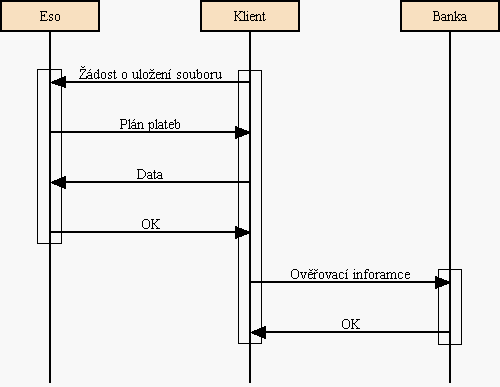 Client generates a request for storage. Eso that receives such a request
tries to allocate requiered space on its disk. If succesful, it generates a
payment plan as well, describing how much and when it will ask for money for
the file storage. This payment plan is sent back to Client.
Current version of Client implicitly agrees with all payment plans it
receives. A function that would show the payment plan to user to dis/agree
should be implented in future.
If user accepts the payment plan, Client prepares file to upload. This
procedure considers the requirement that Bank should be able to proove that
Eso really stores the file it is asking money for. This is reached by
concatenating a different random string to a file for each Eso the file is
going to be stored to. The result is encrypted with Client's private key
and this data are finally send to Eso along with Client's public key.
Before sending data to Eso there is generated one more random string
(OAuth), which is added to encrypted data. MAC (Message Authentication
Code) is counted from the result. Client stores all OAuth - MAC pairs.
Client generates a request for storage. Eso that receives such a request
tries to allocate requiered space on its disk. If succesful, it generates a
payment plan as well, describing how much and when it will ask for money for
the file storage. This payment plan is sent back to Client.
Current version of Client implicitly agrees with all payment plans it
receives. A function that would show the payment plan to user to dis/agree
should be implented in future.
If user accepts the payment plan, Client prepares file to upload. This
procedure considers the requirement that Bank should be able to proove that
Eso really stores the file it is asking money for. This is reached by
concatenating a different random string to a file for each Eso the file is
going to be stored to. The result is encrypted with Client's private key
and this data are finally send to Eso along with Client's public key.
Before sending data to Eso there is generated one more random string
(OAuth), which is added to encrypted data. MAC (Message Authentication
Code) is counted from the result. Client stores all OAuth - MAC pairs.
 When Eso receives the data to store, it checkes wether allocation took place
before and saves the file. After that Eso sends a confirmation message to
Client.
Now for each planned payment Client sends to Bank appropriate OAuth - MAC pair
and waits until confirmation from Bank arrives.
To explain why there is so much hacking around the file storage is not the
purpose of this document. Look for it somewhere else (try e.g. Tonda Benes -
idea author).
--------------------------------------------------------------------------------
12.3.1.2. File search and download scenarios
--------------------------------------------------------------------------------
12.3.1.2.1. Search trees
Each file is uploaded into the Service together with a unique identificator
(ffid) and some keywords. According to these pieces of information one can
find and download the file. The access certificates of Eternity Servers
change in time (because of expiration time - see section Access Certificates
and Contacting the servers). Thus even the person, who uploaded the file may
not know any of the valid certificates of Eso that stores the file. The
search for file is done using the search tree (vertices are Esos). The depth
and width of the search tree are specified by the user, but each Eso can lower
these numbers by a constant specified in the config file. Configuring these
parameters disables any attackers to fill up the system with many messages by
specifying very large and deep search tree. The picture shows a search tree of
depth 2.
When Eso receives the data to store, it checkes wether allocation took place
before and saves the file. After that Eso sends a confirmation message to
Client.
Now for each planned payment Client sends to Bank appropriate OAuth - MAC pair
and waits until confirmation from Bank arrives.
To explain why there is so much hacking around the file storage is not the
purpose of this document. Look for it somewhere else (try e.g. Tonda Benes -
idea author).
--------------------------------------------------------------------------------
12.3.1.2. File search and download scenarios
--------------------------------------------------------------------------------
12.3.1.2.1. Search trees
Each file is uploaded into the Service together with a unique identificator
(ffid) and some keywords. According to these pieces of information one can
find and download the file. The access certificates of Eternity Servers
change in time (because of expiration time - see section Access Certificates
and Contacting the servers). Thus even the person, who uploaded the file may
not know any of the valid certificates of Eso that stores the file. The
search for file is done using the search tree (vertices are Esos). The depth
and width of the search tree are specified by the user, but each Eso can lower
these numbers by a constant specified in the config file. Configuring these
parameters disables any attackers to fill up the system with many messages by
specifying very large and deep search tree. The picture shows a search tree of
depth 2.
 --------------------------------------------------------------------------------
12.3.1.2.2. Search for file vs. download
We distinguish terms search and download. User, who does not know the unique
identificator (ffid) of file first SEARCHES for file using its keywords. To
prevent useless transports of large data, we proposed a protocol, in which the
responses to request for search are just headers of found files with further
information (now only the appproximate size) about the file and its ffid.
--------------------------------------------------------------------------------
12.3.1.2.2. Search for file vs. download
We distinguish terms search and download. User, who does not know the unique
identificator (ffid) of file first SEARCHES for file using its keywords. To
prevent useless transports of large data, we proposed a protocol, in which the
responses to request for search are just headers of found files with further
information (now only the appproximate size) about the file and its ffid.
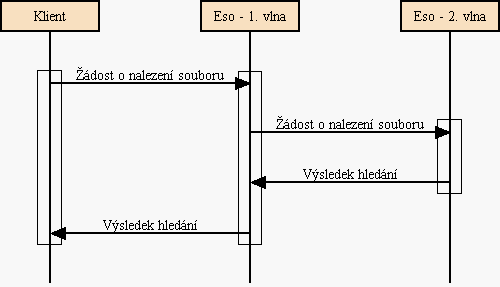 According to the ffid the user can send a request for downloading the file.
According to the ffid the user can send a request for downloading the file.
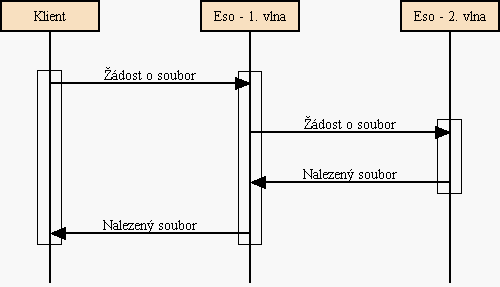 --------------------------------------------------------------------------------
12.3.1.2.3. Forwarding and safety
Each Eso that is not a leaf of the search tree must store pieces of
information about the Six (Client or Eso) that sent the request for download
or search. These pieces of information are stored on the server only for the
time necessary to search through the rest of the search tree. This method
cannot be used in the contrary way (to save the information, where was the
data found and thus make easier the download). The information "who sent the
data" is much less critical than the information "who has the data". Storing
the information about the owner is again good for the enemy, who is looking
for the machine that owns the data. While downloading the file the search
tree is thus created once more (nobody knows, where the requested file is) and
there is a possibility, that in this case the file will not be found.
--------------------------------------------------------------------------------
12.3.1.2.4. Cutting through the answers
Each file can be stored in Service in several copies (all of them have the
same ffid and keywords). The user doesn't care, which copy he gets. To
prevent the enemy to find out, how many copies there are in the Service, the
answers to request for searchand download are on each non-leaf Eso cut through
and the user gets only one of responses with the same ffid.
--------------------------------------------------------------------------------
12.3.1.2.5. Summary
For search and download the search trees are used. Request for download must
contain the unique indentificator of the file. For search keywords are needed.
For each search or download new search tree is generated. The answers are on
each non-leaf Eso cut through and user gets from one search tree only one
answer about each found file.
--------------------------------------------------------------------------------
12.3.1.3. Payment for stored data scenario
--------------------------------------------------------------------------------
12.3.1.2.3. Forwarding and safety
Each Eso that is not a leaf of the search tree must store pieces of
information about the Six (Client or Eso) that sent the request for download
or search. These pieces of information are stored on the server only for the
time necessary to search through the rest of the search tree. This method
cannot be used in the contrary way (to save the information, where was the
data found and thus make easier the download). The information "who sent the
data" is much less critical than the information "who has the data". Storing
the information about the owner is again good for the enemy, who is looking
for the machine that owns the data. While downloading the file the search
tree is thus created once more (nobody knows, where the requested file is) and
there is a possibility, that in this case the file will not be found.
--------------------------------------------------------------------------------
12.3.1.2.4. Cutting through the answers
Each file can be stored in Service in several copies (all of them have the
same ffid and keywords). The user doesn't care, which copy he gets. To
prevent the enemy to find out, how many copies there are in the Service, the
answers to request for searchand download are on each non-leaf Eso cut through
and the user gets only one of responses with the same ffid.
--------------------------------------------------------------------------------
12.3.1.2.5. Summary
For search and download the search trees are used. Request for download must
contain the unique indentificator of the file. For search keywords are needed.
For each search or download new search tree is generated. The answers are on
each non-leaf Eso cut through and user gets from one search tree only one
answer about each found file.
--------------------------------------------------------------------------------
12.3.1.3. Payment for stored data scenario
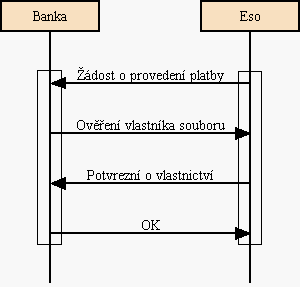 When the time for a payment for stored data comes up, the Eso
contacts the correspondent Bank and identifies the payment.
The Bank tries to search the record with given payment. If it has
not succeeded, it sends to the Eso a negative answer. Such answer
it sends also when the date in the record is not came up. Otherwise
it challenges the Eso to compute MAC (by sending OAuth to it).
OAuth is secret key served for computing checksum (MAC), which is
used for proving ownership of the file (see chapter 11.10). The
Client sends this key to the Bank in payment plan, when storing
his data.
Based on received OAuth and commited data the Eso compute MAC. This
checksum it sends together with SAuth to the Bank.
The Bank compares its information with the arrival ones and if
everything is OK, transfer the money from the anonymous account to
Eso's accout.
--------------------------------------------------------------------------------
12.3.1.4. Time synchronization scenario
When the time for a payment for stored data comes up, the Eso
contacts the correspondent Bank and identifies the payment.
The Bank tries to search the record with given payment. If it has
not succeeded, it sends to the Eso a negative answer. Such answer
it sends also when the date in the record is not came up. Otherwise
it challenges the Eso to compute MAC (by sending OAuth to it).
OAuth is secret key served for computing checksum (MAC), which is
used for proving ownership of the file (see chapter 11.10). The
Client sends this key to the Bank in payment plan, when storing
his data.
Based on received OAuth and commited data the Eso compute MAC. This
checksum it sends together with SAuth to the Bank.
The Bank compares its information with the arrival ones and if
everything is OK, transfer the money from the anonymous account to
Eso's accout.
--------------------------------------------------------------------------------
12.3.1.4. Time synchronization scenario
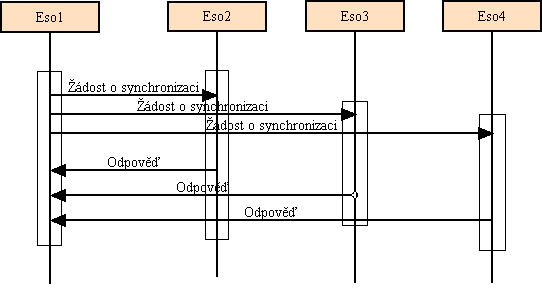 Time synchronization starts when expired timeout of beginning of
synchronization. Requests for time are send to random Esos, it is set new
unique identification number for this synchronization, time of
synchronizatin's beginning, timeout to synchronization's ending and timeout to
new synchronization's beginning.
When some Eso gets request for time, this Eso adds the actual time to request
message and sends it back to sender. Return address is included in request
message.
The Eso which starts synchronization stores responses into the table. When
number of responses is greater than number that we need, this Eso starts to
compute divergence from system time. At the first responses are sorted by
time, then extreme values are deleted and it is computed average from all
values. If divergence is greater than is possible, information about it is
written to logfile and in Scheduler state of system time is set as bad time.
When timeout of ending synchronization is expired, actual synchronization is
break off and information about it is written to logfile.
Alternative calculation of divergence can be this formula:
divergence = ((t3 - t2) - (t2 - t1))/2
t1 ... beginning of synchronization
t2 ... time of getting request
t3 ... time of getting response
We assume that time to other Eso and back is almost the same.
Other alternative is computing median from divergences than compute average.
The median has better quality.
--------------------------------------------------------------------------------
12.3.2. Protocols
--------------------------------------------------------------------------------
12.3.2.1. Six-Six
Time synchronization starts when expired timeout of beginning of
synchronization. Requests for time are send to random Esos, it is set new
unique identification number for this synchronization, time of
synchronizatin's beginning, timeout to synchronization's ending and timeout to
new synchronization's beginning.
When some Eso gets request for time, this Eso adds the actual time to request
message and sends it back to sender. Return address is included in request
message.
The Eso which starts synchronization stores responses into the table. When
number of responses is greater than number that we need, this Eso starts to
compute divergence from system time. At the first responses are sorted by
time, then extreme values are deleted and it is computed average from all
values. If divergence is greater than is possible, information about it is
written to logfile and in Scheduler state of system time is set as bad time.
When timeout of ending synchronization is expired, actual synchronization is
break off and information about it is written to logfile.
Alternative calculation of divergence can be this formula:
divergence = ((t3 - t2) - (t2 - t1))/2
t1 ... beginning of synchronization
t2 ... time of getting request
t3 ... time of getting response
We assume that time to other Eso and back is almost the same.
Other alternative is computing median from divergences than compute average.
The median has better quality.
--------------------------------------------------------------------------------
12.3.2. Protocols
--------------------------------------------------------------------------------
12.3.2.1. Six-Six
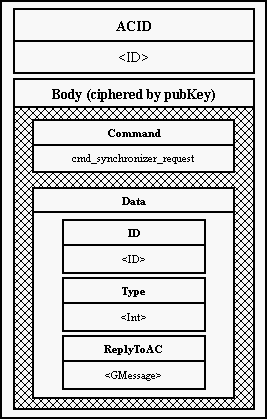
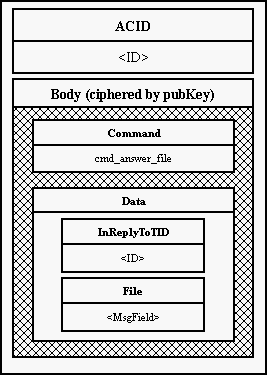
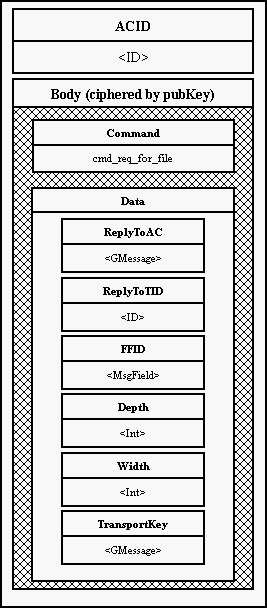
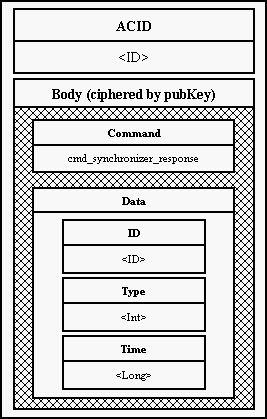
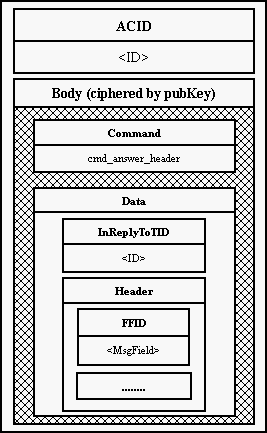
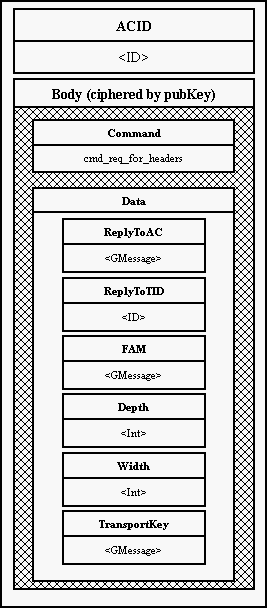
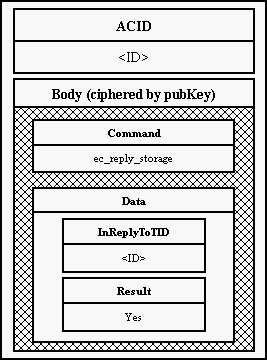
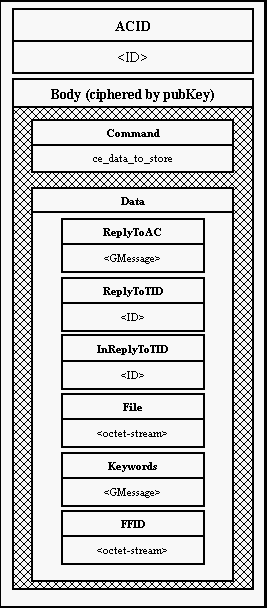
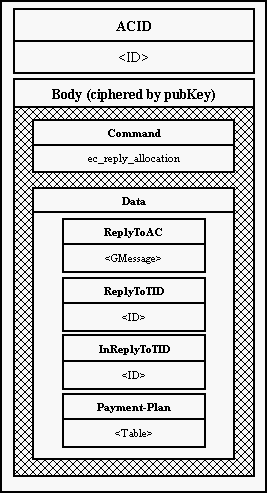
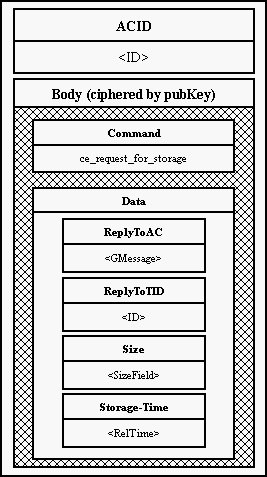
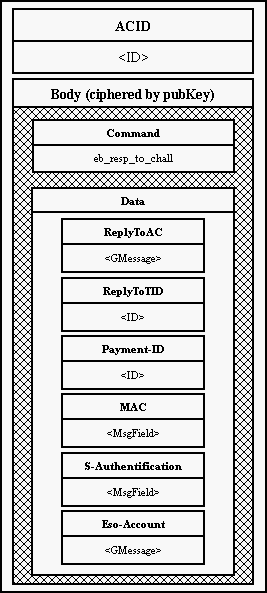
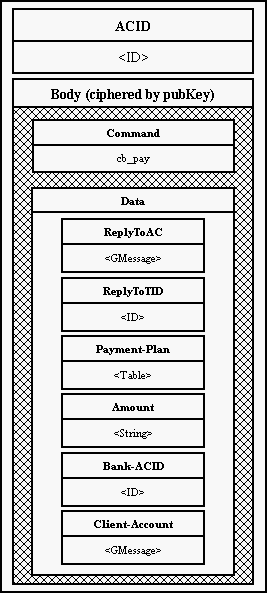
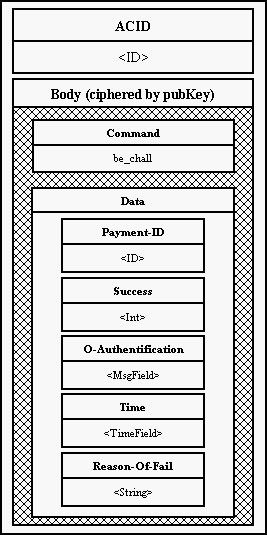
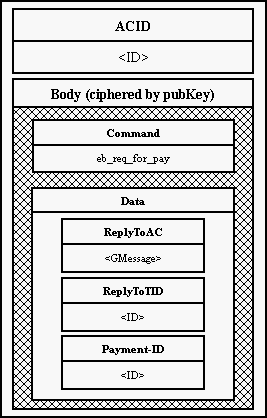
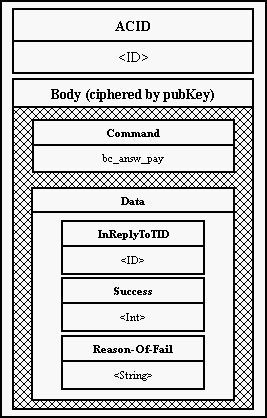
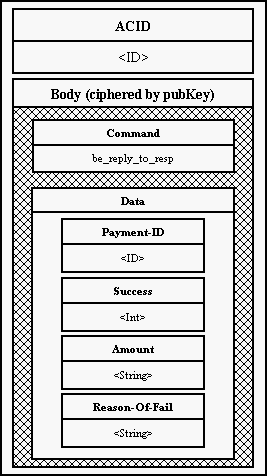 --------------------------------------------------------------------------------
12.3.2.2. Six-Mix
--------------------------------------------------------------------------------
12.3.2.2. Six-Mix




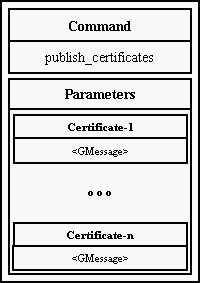
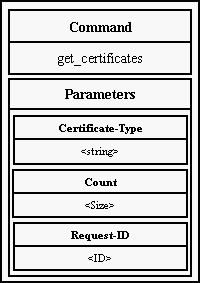
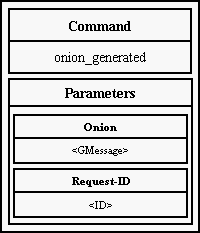
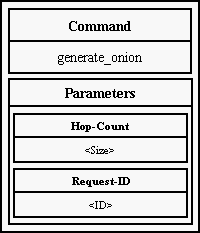
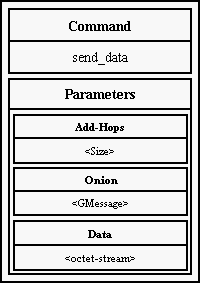

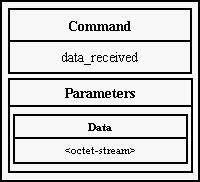 --------------------------------------------------------------------------------
12.4. Common objects
--------------------------------------------------------------------------------
12.4.1. LogFile
Enables other objects to write debug messages, warnings and errors to log
file.
--------------------------------------------------------------------------------
12.4.2. ConfigFile
This class represents a configuration file and allows other objets
to access information stored in it. Configuratio is stored in afile
where lines beginning whith '#' and empty lines are ignored
(considered to be comments).
First word on each line is considered to be key and the rest of
line is the value. These pairs are then stored in memmory in a hash
array for fast access (STL is used here). This array is protected
by alock so save reload of config file should be possible.
All objects shoul not keep its copies of configuration data and
should ask ConfigFile as this ensures data consistency.
--------------------------------------------------------------------------------
12.4.3. Cipherer
Cipherer is a wrapper for RSARef toolkit. Its methods enable to process
data of any length (ie. data given needn't be aligned to blocks of some
bytes). The cipherer gets the data in the form of MsgField or GMessage,
because almost all data are transmitted in one of these objects.
Methods of Cipherer can do:
- to encode data with asymetric algorithm (currently, combination of
asymetric and symetric cryphtography is used, but it is transparent for
the programmer)
- to decode that data
- to encode and decode data with symetric algorithm, no block alignment is
needed
- MD5
- digital signature
- to encode and decode a symetric key (in the form of GMessage) with RSA
- special methods for asymetric coding, for onion creation and for adding
new peels on the top of existing onion
--------------------------------------------------------------------------------
12.4.4. Data alignment
During symetric encoding the data is padded to the block alignment and with
information about the length (withou padding bytes) it is all encoded.
During decoding, padding bytes are thrown away.
--------------------------------------------------------------------------------
12.4.5. Asymetric coding
Encoding of big data would be very slow if we used only RSA algorithm. So
we implement it as a combination of asym and sym algorithms. Firstly, a
temporary symetric key is generated. The data is encoded with this symetric
key. Afterwards this key is encoded with public key of the recipient. The
encoded symetric key and encoded data are given together and can be sent
over unsecure network.
Cipherer is used in Mix mainly by objects Translator and MessageCreator,
but Cipherer is quite generic object, portable to another programs.
--------------------------------------------------------------------------------
12.4.6. Receiver
Receiver is an object that accepts messages form the Net. He parses the
message into the GMessage object and sends it then Translator. Parsing the
data given is a simple check whether the data is in the form of GMessage.
Bad data are thrown away and a note to the log is written.
When data is OK, Receiver adds field Origin into the built GMessage. This
field then identifies the GMessage inside of the Mix.
Receiver listens to the port that is written is the config file. This port
with IP address is included into the Mix certificate.
--------------------------------------------------------------------------------
12.4.7. Sender
Gets messages consisted of the data part and than several records
(currently 1 or 2) containing port and address where the message can be
sent to. Sender takes all records in turn and tries to connect. When
succesful, inserts the record into the data part (data part is GMessage
too) and sends the data and than goes for waiting for the next message.
Sender is used for communication Mix-Mix or Mix-Six. Sender in
Six adds Six's identification (Six's name written in config file for Six
and Mix) into the message. This added identification is for Mix to identify
where the message came from. No check is made, because we assume that Six
and its local Mix are running on a controled network (typically the same
secured machine). Some security can be added with firewall settings or so.
This information mean that no encoding is used for communication between
Mix-Six. If needed, use ssh tunneling, for example.
--------------------------------------------------------------------------------
12.4.8. GMessage
GMessage is a flexible structure letting us work with messages in a simple
way. Each GMessage holds several named fields (MsgField), which can keep
data of any type. These fields provide a lot of conversion methods to
simplify sending & receiving data of different types.
Nesting is one of the most important properties of GMessage which goes hand
in hand with the layered architecture of Eternity Service.
All messages being sent in the system are created and parsed using
GMessage.
--------------------------------------------------------------------------------
12.4.9. MessageQueue
MessageQueue is a shit. Should be written with STL, but isn't. Do not ask
us why.
--------------------------------------------------------------------------------
12.4.10. Debugable
This class is the ancesstor of all objects that want to write into LogFile. It
keeps a pointer to LogFile that is written to by default. Runnable is a child
of this class. This class also encapsulates the setting of current level of
debug messages that shoul be written to the log file. This level can be set
for log file and then different one for particular objects.
It sholud be possible to set the debug level through config file. Now it is
possible to set this level just at compile time. There is a syntax highliting
file in the distribution that paints the logs with nice colors ;-)
--------------------------------------------------------------------------------
12.4.11. Runable
It represents an object that runs as a standalone thread. This class enforces
implementation of method Run() that is run in the thread. Some of the Runnable
objects are Sender, Receiver, Translator, Linker, Majordomo's etc. All these
objects are marked as ovals. The method Run of Runable object cannot be passed
to pthread_create() directly so a wrapper function is used instead. This
function just calls method Run of specified object.
--------------------------------------------------------------------------------
12.4.12. RandomGenerator
An object that generates random bytes. RandomGenerator uses random() function
that is seeded using data read from /dev/urandom. This object may be rewritten
tousesomehardware randomgeneratorto generate "better" data.
There was a problem with reading /dev/urandom on FreeBSD 2.2.6 so we seed
using time if reading fails - just for testing.
--------------------------------------------------------------------------------
13. Summary
After one year of work on this project, we designed and implemented a
functional framework of the Service. We implemented private and anonymous
communication medium, that is realized by virtual net consisted of Mix servers.
We designed an abstraction of a server that uses this virtual net and we made
use of this abstraction for implementing of basic servers needed for
functionality of the Service. These servers are Eternity server (Eso) that
ensures higly reliable availibility of data that is stored on this server.
Next, we implemented Access Certificate Server (ACS) that is a gate to the
Service and ensures distribution of information about how to contact another
servers. Pro user access to the Service, we implemented Client that enables to
access to services provided by the Service. Except of this, we made a program
that could become a core for software included into financial institutions that
would want to support the Service (ie. provision of anonymous accounts).
----------------------------------------------------------------------
14. Conclusion and Thanks
First of all, we would like to thank our project leader, Tonda Benes for cool
idea of starting this project. Because of this, we got a perfect chance to
learn a lot of new things, theoretically interesting and yet usable in a real
computer life. FreeBSD system, unknown for us before, helped us to get more
deeply into the fascinating world of Unix. Last, but not least, we would like
to thank Ken Thompson for Unix philosophy, Dennis Ritchie for C, Bjarne
Stroustrup for ++, UCLA for BSD and vi, Bram Moolenaar for m, FreeBSD Org for
system, Microsoft Senior Recruiter Meggie Gougan for a nice password, Italians
for spagetti and Metallica, Alanis Morissette and Rolling Stones for support.
--------------------------------------------------------------------------------
15. Literature
[And] - R. J. Anderson - The Eternity Service, lesson published at
Pragocrypt'96
[TB1] - A. Benes - The Eternity Service - A New Solution to the Data
Storage and Recovery Problem? - preliminary study, unpublished
[TB2] - A. Benes - How To Achieve the Eternity, manuscript, published in
Datasem 98 Proceedings, 1998
[Cha] - D. Chaum - Untraceable Electronic Mail, Return Addresses, and
Digital Pseudonyms, Communications of the ACM, vol. 24, Feb. 1981
[Gold] - D. M. Goldschlag et.al. - Hiding Routing Information, Workshop on
Information Hiding, Cambridge, UK, May 1996
[MCST] - RFC1301 - Multicast transport protocol
[Rand] - RFC1750 - Randomness recommendations for cryptography
[RSVP] - RFC 2205 - The resource reservation protocol
[X509] - CCITT Recommendation X.509, The Directory-Authentication
Framework, Blue Book - Melbourne 1988
[Kal] Cryptographic Message Syntax by B. Kaliski
[Lef] Samuel J. Leffler - The Design and implementation of the 4.3 BSD Unix
operating system
[POS] POSIX Thread Primer
[Sem] Semaphores for threads - C++ library
[Bee] Beej's Guide to Socket Programming
[4.4] 4.4 BSD IPC tutorial
[FBSD] Documents from the official FreeBSD site (www.freebsd.org)
[Man] Manual pages of FreeBSD operating system
[GNU] GNU manuals for gmake, gdb, gcc
================================================================================
--------------------------------------------------------------------------------
12.4. Common objects
--------------------------------------------------------------------------------
12.4.1. LogFile
Enables other objects to write debug messages, warnings and errors to log
file.
--------------------------------------------------------------------------------
12.4.2. ConfigFile
This class represents a configuration file and allows other objets
to access information stored in it. Configuratio is stored in afile
where lines beginning whith '#' and empty lines are ignored
(considered to be comments).
First word on each line is considered to be key and the rest of
line is the value. These pairs are then stored in memmory in a hash
array for fast access (STL is used here). This array is protected
by alock so save reload of config file should be possible.
All objects shoul not keep its copies of configuration data and
should ask ConfigFile as this ensures data consistency.
--------------------------------------------------------------------------------
12.4.3. Cipherer
Cipherer is a wrapper for RSARef toolkit. Its methods enable to process
data of any length (ie. data given needn't be aligned to blocks of some
bytes). The cipherer gets the data in the form of MsgField or GMessage,
because almost all data are transmitted in one of these objects.
Methods of Cipherer can do:
- to encode data with asymetric algorithm (currently, combination of
asymetric and symetric cryphtography is used, but it is transparent for
the programmer)
- to decode that data
- to encode and decode data with symetric algorithm, no block alignment is
needed
- MD5
- digital signature
- to encode and decode a symetric key (in the form of GMessage) with RSA
- special methods for asymetric coding, for onion creation and for adding
new peels on the top of existing onion
--------------------------------------------------------------------------------
12.4.4. Data alignment
During symetric encoding the data is padded to the block alignment and with
information about the length (withou padding bytes) it is all encoded.
During decoding, padding bytes are thrown away.
--------------------------------------------------------------------------------
12.4.5. Asymetric coding
Encoding of big data would be very slow if we used only RSA algorithm. So
we implement it as a combination of asym and sym algorithms. Firstly, a
temporary symetric key is generated. The data is encoded with this symetric
key. Afterwards this key is encoded with public key of the recipient. The
encoded symetric key and encoded data are given together and can be sent
over unsecure network.
Cipherer is used in Mix mainly by objects Translator and MessageCreator,
but Cipherer is quite generic object, portable to another programs.
--------------------------------------------------------------------------------
12.4.6. Receiver
Receiver is an object that accepts messages form the Net. He parses the
message into the GMessage object and sends it then Translator. Parsing the
data given is a simple check whether the data is in the form of GMessage.
Bad data are thrown away and a note to the log is written.
When data is OK, Receiver adds field Origin into the built GMessage. This
field then identifies the GMessage inside of the Mix.
Receiver listens to the port that is written is the config file. This port
with IP address is included into the Mix certificate.
--------------------------------------------------------------------------------
12.4.7. Sender
Gets messages consisted of the data part and than several records
(currently 1 or 2) containing port and address where the message can be
sent to. Sender takes all records in turn and tries to connect. When
succesful, inserts the record into the data part (data part is GMessage
too) and sends the data and than goes for waiting for the next message.
Sender is used for communication Mix-Mix or Mix-Six. Sender in
Six adds Six's identification (Six's name written in config file for Six
and Mix) into the message. This added identification is for Mix to identify
where the message came from. No check is made, because we assume that Six
and its local Mix are running on a controled network (typically the same
secured machine). Some security can be added with firewall settings or so.
This information mean that no encoding is used for communication between
Mix-Six. If needed, use ssh tunneling, for example.
--------------------------------------------------------------------------------
12.4.8. GMessage
GMessage is a flexible structure letting us work with messages in a simple
way. Each GMessage holds several named fields (MsgField), which can keep
data of any type. These fields provide a lot of conversion methods to
simplify sending & receiving data of different types.
Nesting is one of the most important properties of GMessage which goes hand
in hand with the layered architecture of Eternity Service.
All messages being sent in the system are created and parsed using
GMessage.
--------------------------------------------------------------------------------
12.4.9. MessageQueue
MessageQueue is a shit. Should be written with STL, but isn't. Do not ask
us why.
--------------------------------------------------------------------------------
12.4.10. Debugable
This class is the ancesstor of all objects that want to write into LogFile. It
keeps a pointer to LogFile that is written to by default. Runnable is a child
of this class. This class also encapsulates the setting of current level of
debug messages that shoul be written to the log file. This level can be set
for log file and then different one for particular objects.
It sholud be possible to set the debug level through config file. Now it is
possible to set this level just at compile time. There is a syntax highliting
file in the distribution that paints the logs with nice colors ;-)
--------------------------------------------------------------------------------
12.4.11. Runable
It represents an object that runs as a standalone thread. This class enforces
implementation of method Run() that is run in the thread. Some of the Runnable
objects are Sender, Receiver, Translator, Linker, Majordomo's etc. All these
objects are marked as ovals. The method Run of Runable object cannot be passed
to pthread_create() directly so a wrapper function is used instead. This
function just calls method Run of specified object.
--------------------------------------------------------------------------------
12.4.12. RandomGenerator
An object that generates random bytes. RandomGenerator uses random() function
that is seeded using data read from /dev/urandom. This object may be rewritten
tousesomehardware randomgeneratorto generate "better" data.
There was a problem with reading /dev/urandom on FreeBSD 2.2.6 so we seed
using time if reading fails - just for testing.
--------------------------------------------------------------------------------
13. Summary
After one year of work on this project, we designed and implemented a
functional framework of the Service. We implemented private and anonymous
communication medium, that is realized by virtual net consisted of Mix servers.
We designed an abstraction of a server that uses this virtual net and we made
use of this abstraction for implementing of basic servers needed for
functionality of the Service. These servers are Eternity server (Eso) that
ensures higly reliable availibility of data that is stored on this server.
Next, we implemented Access Certificate Server (ACS) that is a gate to the
Service and ensures distribution of information about how to contact another
servers. Pro user access to the Service, we implemented Client that enables to
access to services provided by the Service. Except of this, we made a program
that could become a core for software included into financial institutions that
would want to support the Service (ie. provision of anonymous accounts).
----------------------------------------------------------------------
14. Conclusion and Thanks
First of all, we would like to thank our project leader, Tonda Benes for cool
idea of starting this project. Because of this, we got a perfect chance to
learn a lot of new things, theoretically interesting and yet usable in a real
computer life. FreeBSD system, unknown for us before, helped us to get more
deeply into the fascinating world of Unix. Last, but not least, we would like
to thank Ken Thompson for Unix philosophy, Dennis Ritchie for C, Bjarne
Stroustrup for ++, UCLA for BSD and vi, Bram Moolenaar for m, FreeBSD Org for
system, Microsoft Senior Recruiter Meggie Gougan for a nice password, Italians
for spagetti and Metallica, Alanis Morissette and Rolling Stones for support.
--------------------------------------------------------------------------------
15. Literature
[And] - R. J. Anderson - The Eternity Service, lesson published at
Pragocrypt'96
[TB1] - A. Benes - The Eternity Service - A New Solution to the Data
Storage and Recovery Problem? - preliminary study, unpublished
[TB2] - A. Benes - How To Achieve the Eternity, manuscript, published in
Datasem 98 Proceedings, 1998
[Cha] - D. Chaum - Untraceable Electronic Mail, Return Addresses, and
Digital Pseudonyms, Communications of the ACM, vol. 24, Feb. 1981
[Gold] - D. M. Goldschlag et.al. - Hiding Routing Information, Workshop on
Information Hiding, Cambridge, UK, May 1996
[MCST] - RFC1301 - Multicast transport protocol
[Rand] - RFC1750 - Randomness recommendations for cryptography
[RSVP] - RFC 2205 - The resource reservation protocol
[X509] - CCITT Recommendation X.509, The Directory-Authentication
Framework, Blue Book - Melbourne 1988
[Kal] Cryptographic Message Syntax by B. Kaliski
[Lef] Samuel J. Leffler - The Design and implementation of the 4.3 BSD Unix
operating system
[POS] POSIX Thread Primer
[Sem] Semaphores for threads - C++ library
[Bee] Beej's Guide to Socket Programming
[4.4] 4.4 BSD IPC tutorial
[FBSD] Documents from the official FreeBSD site (www.freebsd.org)
[Man] Manual pages of FreeBSD operating system
[GNU] GNU manuals for gmake, gdb, gcc
================================================================================